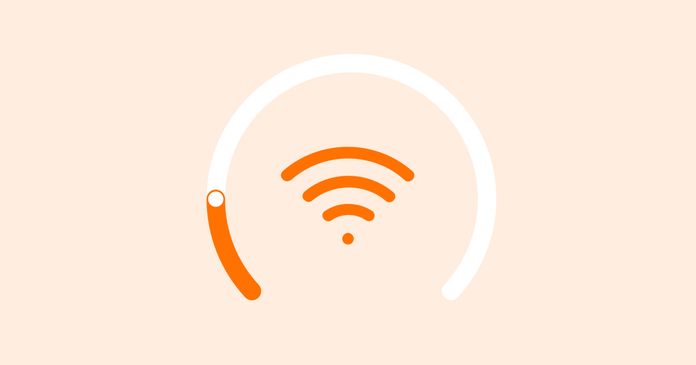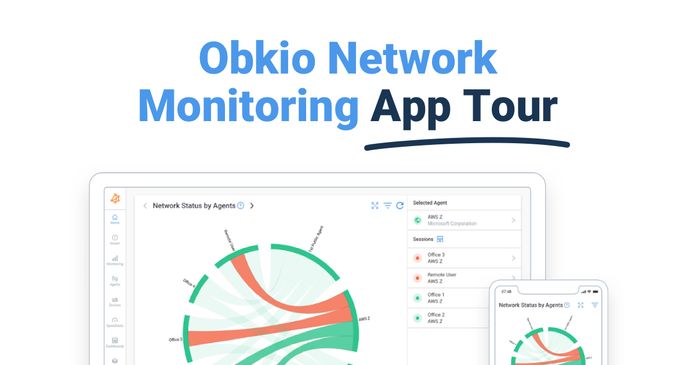Table of Contents
Table of Contents
In today's interconnected world, maintaining seamless network connectivity is crucial for businesses and organizations of all sizes.
Network connection monitoring tools play a vital role in ensuring the performance, security, and reliability of network connections. With a myriad of options available, choosing the right monitoring tool can be a daunting task. To simplify the process, we have curated a comprehensive list of the top 30 network connection monitoring tools.
We decided to create this article to provide a comprehensive overview of the market, as we understand that many existing listings can be biased or overly promotional, leading to confusion. Our goal is to offer an unbiased and informative resource that helps you navigate the world of network connection monitoring tools with clarity and confidence.
We want to clarify that our intention is not to provide our own subjective opinion on the network connection monitoring tools listed. Instead, our goal is to present you with a comprehensive list that allows you to evaluate and assess each solution yourself. We aim to equip you with the necessary information and insights to make an informed decision based on your specific needs and requirements. The ultimate objective is to empower you to find the most suitable network connection monitoring tool that aligns with your organization's goals and ensures seamless connectivity.
From real-time performance monitoring to traffic analysis and security enhancements, these tools offer a range of features to optimize network connectivity. Whether you're a small business, a growing enterprise, or an IT professional seeking to enhance your network infrastructure, this article provides an in-depth overview of the top network connection monitoring tools available today.
Join us as we explore these powerful tools that are designed to deliver seamless connectivity, streamline operations, and empower you to stay ahead in the fast-paced world of network management.
A network connection monitoring tool is a software or hardware solution designed to monitor and analyze network connections within an IT infrastructure. These tools help IT professionals and network administrators monitor the health, performance, and security of network connections in real-time.
Network connection monitoring tools provide insights into various aspects of network connectivity, such as bandwidth utilization, latency, and packet loss, network traffic patterns, and device availability. They often offer features like network performance monitoring, network traffic analysis, network mapping, and alerting/notification systems.
By utilizing network connection monitoring tools, organizations can proactively identify and troubleshoot network issues, optimize network performance, ensure reliable connectivity, and enhance overall network security. These tools are particularly valuable in complex network environments where multiple devices, servers, and applications are interconnected.
Examples of popular network connection monitoring tools include Obkio, Wireshark, Nagios, SolarWinds Network Performance Monitor, PRTG Network Monitor, Zabbix, Cisco Prime Infrastructure, and NetFlow Analyzer, among others. These tools vary in terms of their functionalities, scalability, and compatibility with different network setups.
In today's digital landscape, maintaining a robust and reliable network connection is crucial for businesses of all sizes. As networks become increasingly complex and interconnected, it becomes essential to have comprehensive visibility into network performance, security, and availability. This is where network connection monitoring tools come into play. These tools offer a wide range of functions that enable IT professionals and network administrators to effectively monitor, analyze, and optimize network connections for seamless network connectivity. Let's explore some of the key functions provided by these tools:
1. Real-time Monitoring and Analysis
Network connection monitoring tools offer real-time monitoring capabilities that allow organizations to track the status and performance of their network connections. These tools collect data on various parameters such as bandwidth usage, latency, packet loss, and network traffic patterns. With real-time monitoring, network administrators can promptly identify and address issues that may impact network performance, ensuring uninterrupted connectivity for users.
2. Bandwidth Monitoring and Management
Effective bandwidth management is crucial for optimizing network performance and ensuring fair resource allocation. Network connection monitoring tools provide insights into bandwidth usage across different devices, applications, and users. Administrators can identify bandwidth-intensive activities, monitor traffic patterns, and implement policies to prioritize critical applications or limit bandwidth for non-essential activities. By effectively managing bandwidth, organizations can prevent network congestion, minimize latency, and deliver a better user experience.
3. Network Traffic Analysis
Understanding network traffic patterns is essential for identifying anomalies, security threats, and bottlenecks within the network. Network connection monitoring tools offer advanced traffic analysis capabilities that enable administrators to visualize and analyze network traffic in detail. These tools can help identify excessive bandwidth consumption, pinpoint suspicious activities or network intrusions, and optimize network routing for improved efficiency.
4. Device and Link Availability Monitoring
Network connection monitoring tools allow administrators to monitor the availability and performance of network devices and links. By continuously monitoring the status of routers, switches, access points, and other network components, administrators can detect device failures or link outages in real-time. This enables swift troubleshooting and minimizes network downtime. Additionally, these tools can generate alerts or notifications when availability thresholds are breached, allowing administrators to take immediate action.
5. Network Mapping and Visualization
Comprehending the intricate network topology is vital for effective network management. Network connection monitoring tools often include network mapping and network visualization features that provide a graphical representation of the network infrastructure. Administrators can view the relationships between devices, understand network segmentation, and identify potential single points of failure. Visualizing the network architecture helps in planning network expansions, optimizing routing paths, and ensuring redundancy for critical connections.
6. Alerting and Notification Systems
Timely detection of network issues is crucial for minimizing the impact on users and preventing extended network outages. Network connection monitoring tools incorporate alerting and notification systems to promptly inform administrators about critical events or threshold breaches. These tools can send notifications via email, SMS, or through centralized management consoles, allowing administrators to proactively address issues and maintain uninterrupted network connectivity.
7. Historical Data and Reporting
Network connection monitoring tools capture and store historical data about network performance, usage trends, and incidents. This historical data provides valuable insights for network capacity planning, trend analysis, and troubleshooting recurring issues. Additionally, these tools often offer reporting capabilities, enabling administrators to generate customized reports on network performance, availability, and security. Such reports are invaluable for assessing network health, compliance auditing, and communicating network status to stakeholders.
In conclusion, network connection monitoring tools offer a comprehensive set of functions that empower organizations to effectively monitor, analyze, and optimize network connections. By leveraging real-time monitoring, bandwidth management, traffic analysis, device availability monitoring, network mapping
Discover the power of network connection monitoring for businesses. Unleash smoother operations, proactive issue resolution, and Obkio's monitoring prowess.
Learn more

Choosing the best network connection monitoring tools requires careful consideration of several factors. Here are some key steps to help you make an informed decision:
- Identify your requirements: Begin by understanding your organization's specific needs and goals. Determine the network size, complexity, and the metrics you want to monitor (e.g., bandwidth, latency, device availability). Consider any specific features or integrations you require, such as support for your network infrastructure or compatibility with your existing monitoring systems.
- Research and compare options: Conduct thorough research on available network connection monitoring tools. Look for reputable vendors and read reviews or case studies to assess their reliability and customer satisfaction. Create a shortlist of tools that align with your requirements and compare their features, scalability, ease of use, and pricing.
- Evaluate key features: Consider the key features offered by each tool. Look for real-time monitoring capabilities, bandwidth management, traffic analysis, device availability monitoring, network mapping, alerting/notification systems, and reporting functionalities. Evaluate how well these features meet your specific needs and if they can provide the insights required to optimize your network connectivity.
- Consider scalability and compatibility: Assess the scalability of the tools to ensure they can accommodate your organization's future growth. Additionally, check the compatibility of the tools with your existing network infrastructure and monitoring systems. Integration with other tools and technologies may be crucial for a seamless monitoring experience.
- Trial and testing: Whenever possible, take advantage of free trials or demos offered by the vendors. This allows you to test the tools firsthand and evaluate their user interface, performance, and overall suitability for your organization's network environment. Involve key stakeholders and network administrators during the testing phase to gather their feedback and insights.
- Vendor support and reputation: Evaluate the vendor's reputation and level of customer support. Check if they provide timely technical assistance, regular software updates, and have a strong track record in the industry. A reliable vendor with good support can make a significant difference in your experience with the tool.
- Consider the total cost of ownership: Evaluate the pricing models and total cost of ownership for the network connection monitoring tools. Compare the upfront costs, licensing fees, and any additional expenses such as training, maintenance, or integration costs. Ensure the chosen tool provides good value for the features and benefits it offers.
- Seek recommendations and consult experts: Reach out to industry peers, IT professionals, or network administrators who have experience with network connection monitoring tools. Their insights and recommendations can provide valuable guidance in making an informed decision.
By following these steps and carefully evaluating the features, scalability, compatibility, and vendor support, you can select the best network connection monitoring tool that meets your organization's specific needs for seamless connectivity and optimal network performance.

When it comes to monitoring network connections, having the right tools is essential for ensuring seamless connectivity and optimal performance. Various categories of network connection monitoring tools cater to different aspects of network monitoring and analysis. In this section, we will delve into the different categories of network connection monitoring tools and explore their functionalities. By understanding these categories, you can make informed decisions and choose the most suitable tools for effectively monitoring and managing your network connections. From pure cloud network performance monitoring tools to all-in-one IT software suites, let's explore the diverse range of options available to meet your specific monitoring needs.
- Pure cloud network performance monitoring tools are specifically designed to focus on collecting and analyzing network performance metrics in cloud-based environments. These tools gather data such as bandwidth utilization, latency, packet loss, and network topology. By continuously monitoring these metrics, they provide a real-time view of network performance, enabling IT teams to identify potential bottlenecks and solve intermittent network issues. With the ability to pinpoint performance degradation, these tools help organizations optimize their network connectivity for seamless and efficient operations.
- Traditional network monitoring tools are widely used for monitoring network traffic and collecting data from network devices like routers, network switches, and firewalls. These tools analyze the collected data to provide insights into network health and performance. They identify potential security threats, anomalies, and network abnormalities that may impact connectivity. By visualizing network traffic patterns and behavior, these tools help IT teams troubleshoot network issues, optimize network configurations, and ensure reliable and secure network connections.
- Open-source network monitoring tools are free and open-source software solutions designed for network monitoring and analysis in cloud environments. These tools offer a range of features, including network discovery, network device monitoring, bandwidth monitoring, and protocol analysis. IT teams can customize and extend these tools according to their specific monitoring requirements. With their flexibility and cost-effectiveness, open-source tools provide organizations with the ability to monitor and analyze their network connections in a tailored and budget-friendly manner.
- All-in-one IT software suites provide a comprehensive suite of tools for IT teams to monitor and manage their entire IT infrastructure. These suites include network monitoring, application monitoring, server monitoring, log monitoring, and security monitoring capabilities. In the context of network connection monitoring, these tools offer features that allow IT teams to monitor the health and performance of their network connections within the broader IT ecosystem. They provide a single platform for monitoring the entire IT environment, streamlining workflows, and improving collaboration among IT teams. With centralized visibility, these tools enable IT teams to proactively manage network connections, ensure seamless connectivity, and maintain the overall health of the IT infrastructure.
- Packet capture-based network monitoring tools capture and analyze network traffic at the packet level. These tools provide granular visibility into network traffic, allowing IT teams to identify and troubleshoot network issues, optimize network performance, and detect potential security threats. By capturing and analyzing individual packets, these tools offer in-depth insights into network behavior, enabling IT teams to diagnose and resolve network connectivity issues more effectively. With the ability to examine network traffic at a detailed level, packet capture-based tools are especially useful for troubleshooting complex network issues and ensuring optimal network performance.
Understanding the different categories of network connection monitoring tools provides organizations with a broad range of options to choose from based on their specific monitoring needs. By selecting the most suitable tools for their network environment, organizations can effectively monitor and manage their network connections, ensuring seamless connectivity and optimal network performance.
In this section, we will explore each solution within the previously mentioned categories, providing you with valuable information about their features, pricing, reviews, user interface, and even the availability of demos. By delving into each category, we aim to give you a holistic view of the diverse range of network connection monitoring tools available.
Whether you're seeking cloud performance monitoring, traditional network monitoring, open-source solutions, all-in-one IT software suites, or packet capture-based tools, we've got you covered. Let's dive in and discover the perfect network connection monitoring tool to ensure seamless connectivity for your organization.
In this section, we will explore six network connection performance monitoring tools that are specifically designed to monitor and optimize network performance. These tools offer real-time insights into bandwidth utilization, latency, packet loss, and other key metrics to ensure seamless connectivity and efficient network operations.
Obkio offers a synthetic network performance monitoring tool that provides real-time monitoring and performance analytics for all network types. This platform offers a range of features, including network latency and loss monitoring, as well as bandwidth monitoring, to help identify network bottlenecks and optimize network performance. Obkio's key features include continuous network testing, automatic alerting, device tracking, and usage reports.
One of the advantages of Obkio's network monitoring tool is its user-friendly interface. The platform's intuitive interface provides real-time insights into network performance, enabling users to detect and troubleshoot network issues quickly. Users can access the network monitoring and testing features via an easy-to-use interface that offers a range of options to identify and address network issues.
Obkio offers a range of dashboards and visualizations that provide real-time data on network performance. The platform offers a home page, agent details page, network session page, data center dynamic dashboard, branch dynamic dashboard, branch dashboard, visual traceroutes, thresholds, and notifications to help users monitor and optimize network performance.
Obkio’s Pricing:
- Free : 2 Agents | 1 Device | 1 User (Limited Functionality)
- $399 / month : 10 Agents | 5 Devices | 2 Users
- $699 / month : 10 Agents | 10 Devices | 5 Users
- Additional Fees for Additional Agent, Device and User
Obkio's pricing is based on a flat monthly fee per monitoring agent, device and users, with no additional costs based on data usage, bandwidth, or other metrics hard to estimate. This transparent pricing model makes it easy for customers to budget for their network monitoring costs without worrying about unexpected charges.
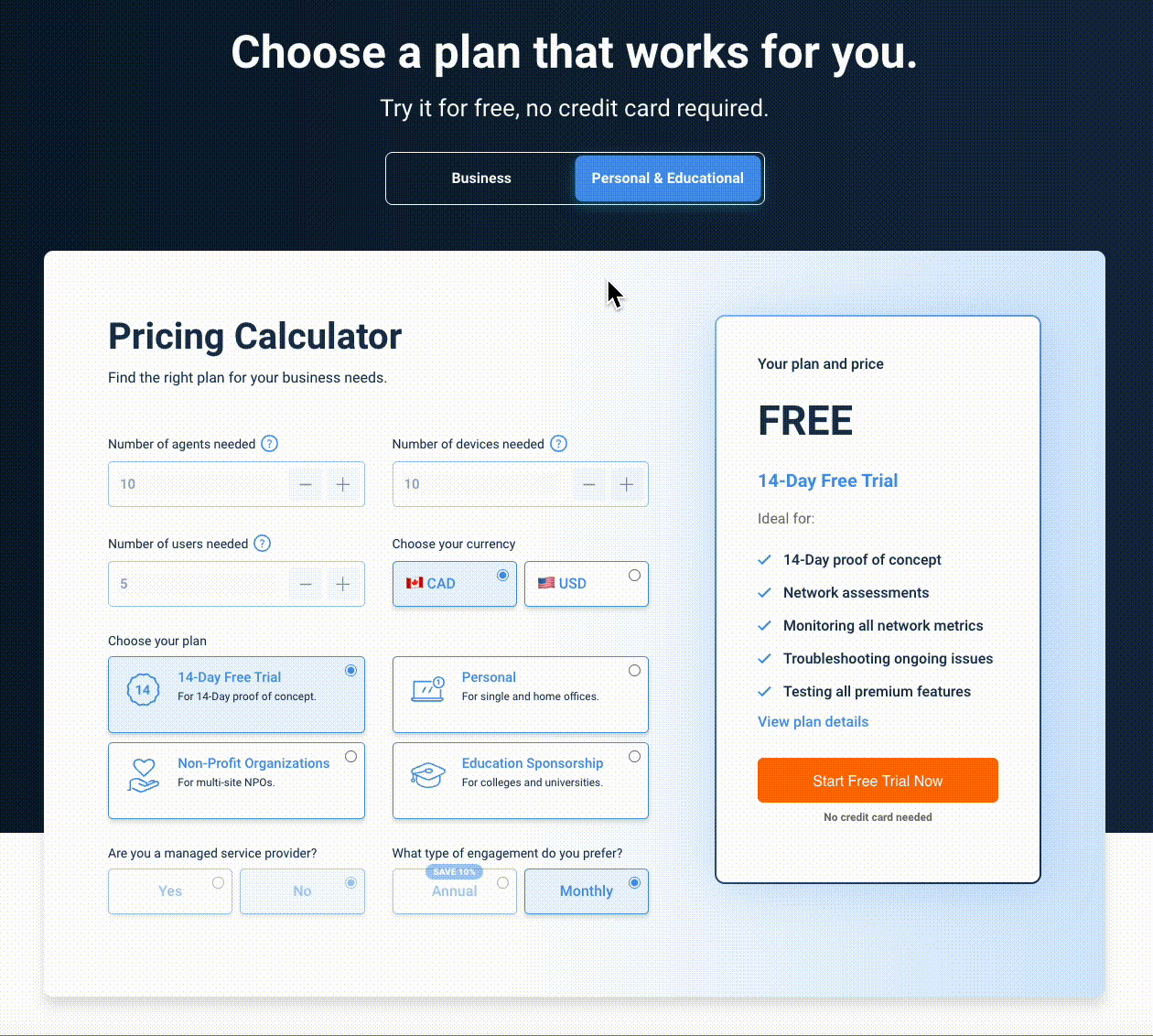
You can use Obkio's Price Calculator to build your custom plan, and get a customized quote that you can use for your business' budgetting and planning needs.
Learn more here : https://obkio.com/pricing/
Free Trial: https://obkio.com/signup/

Obkio’s App Interface:
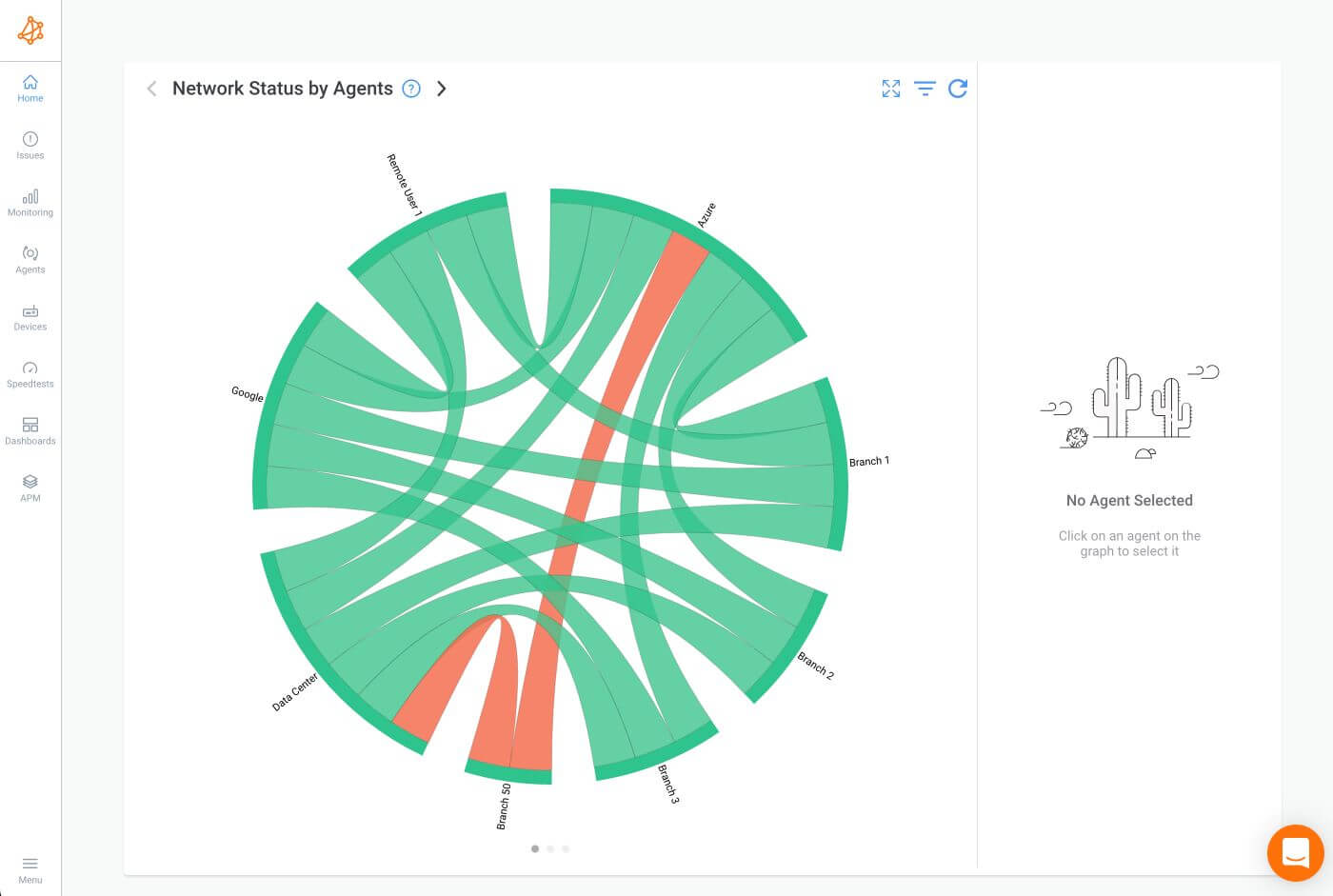
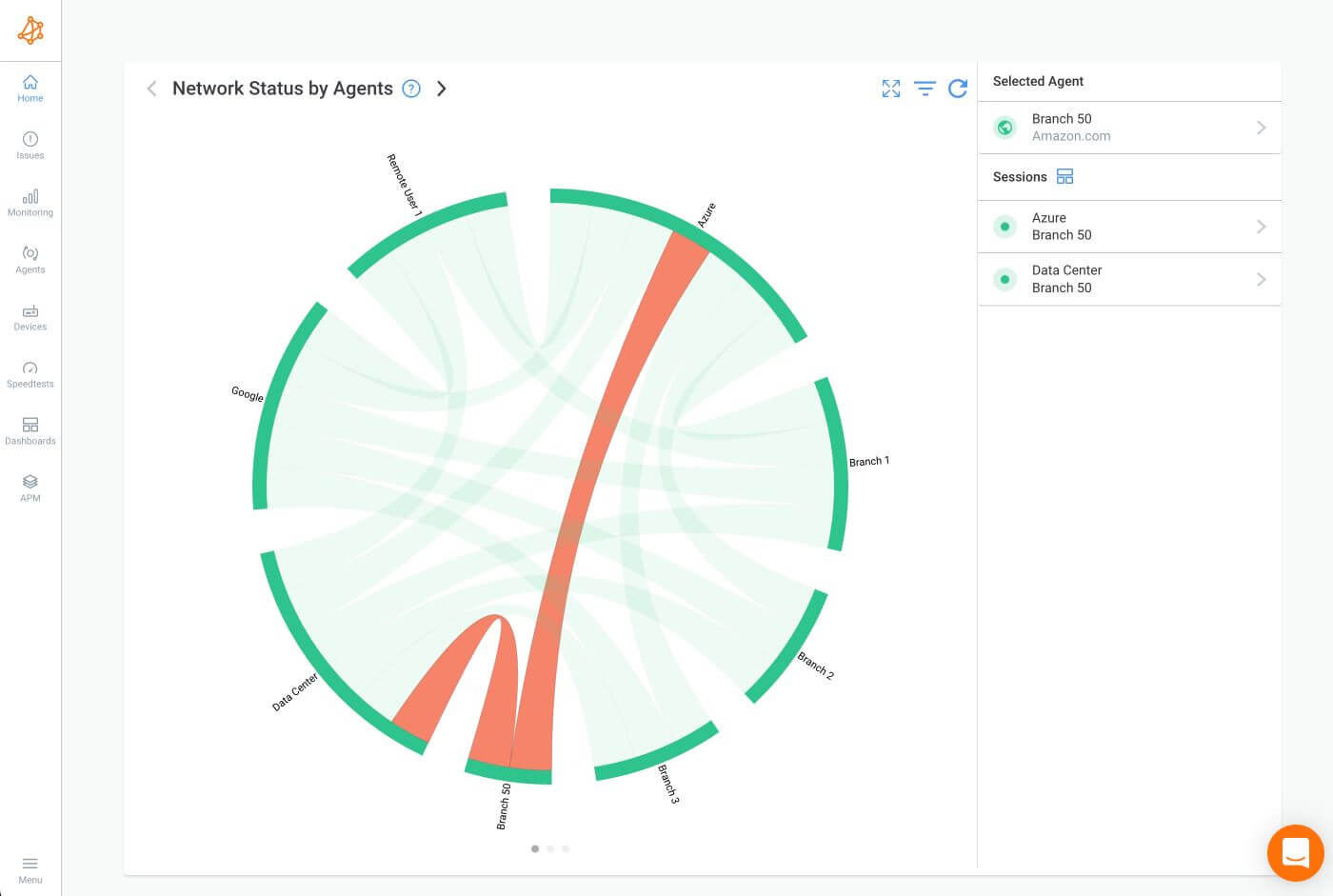
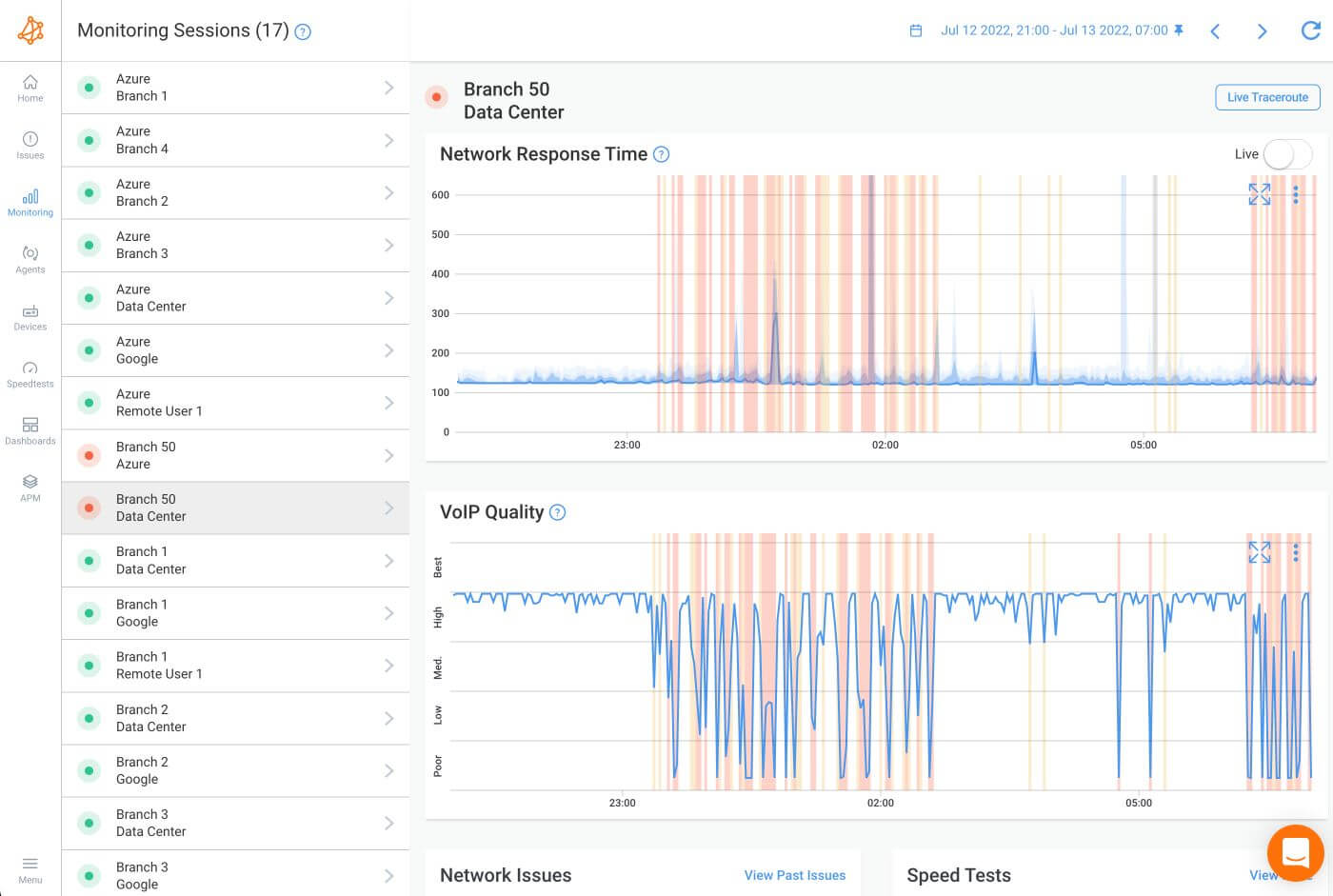

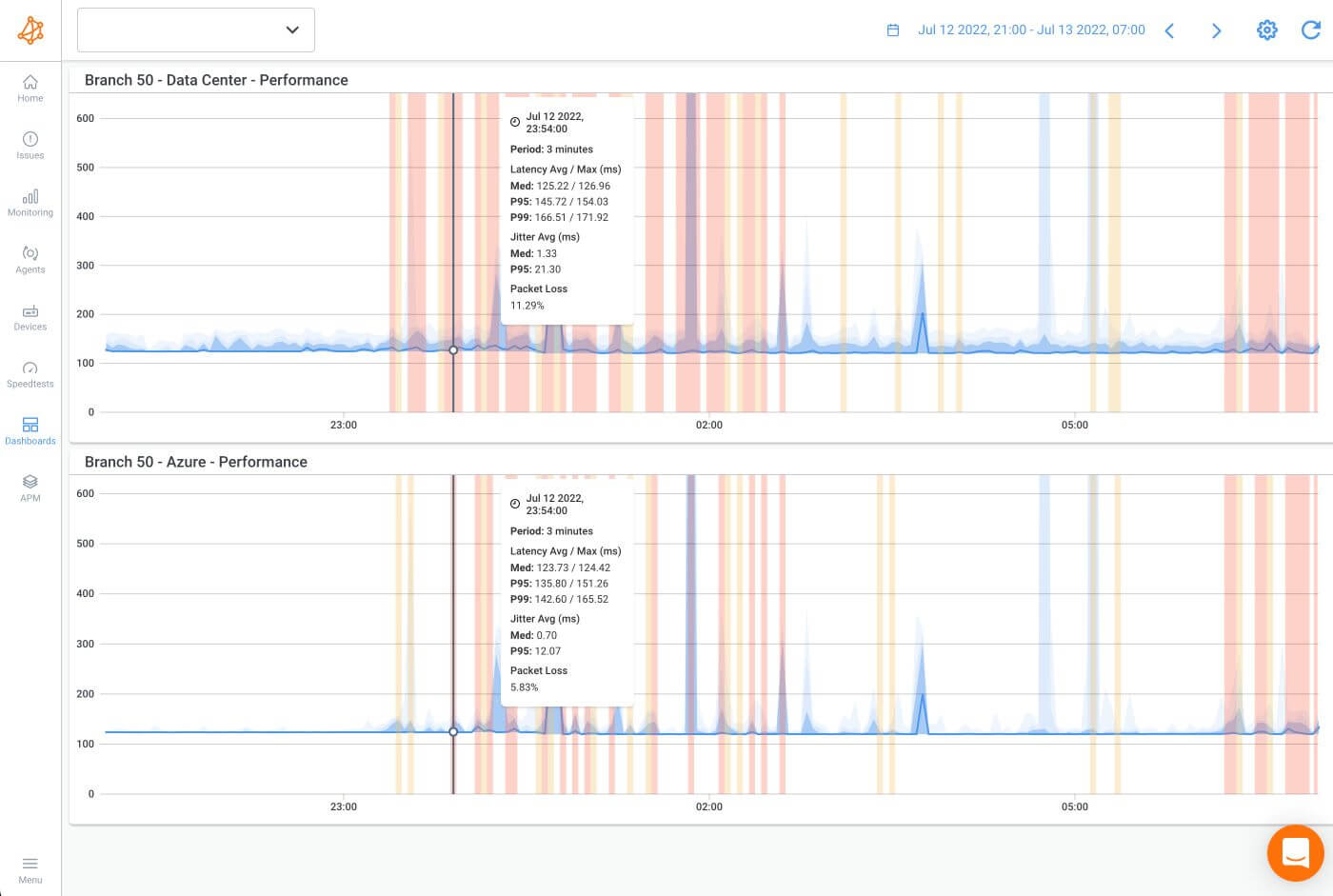
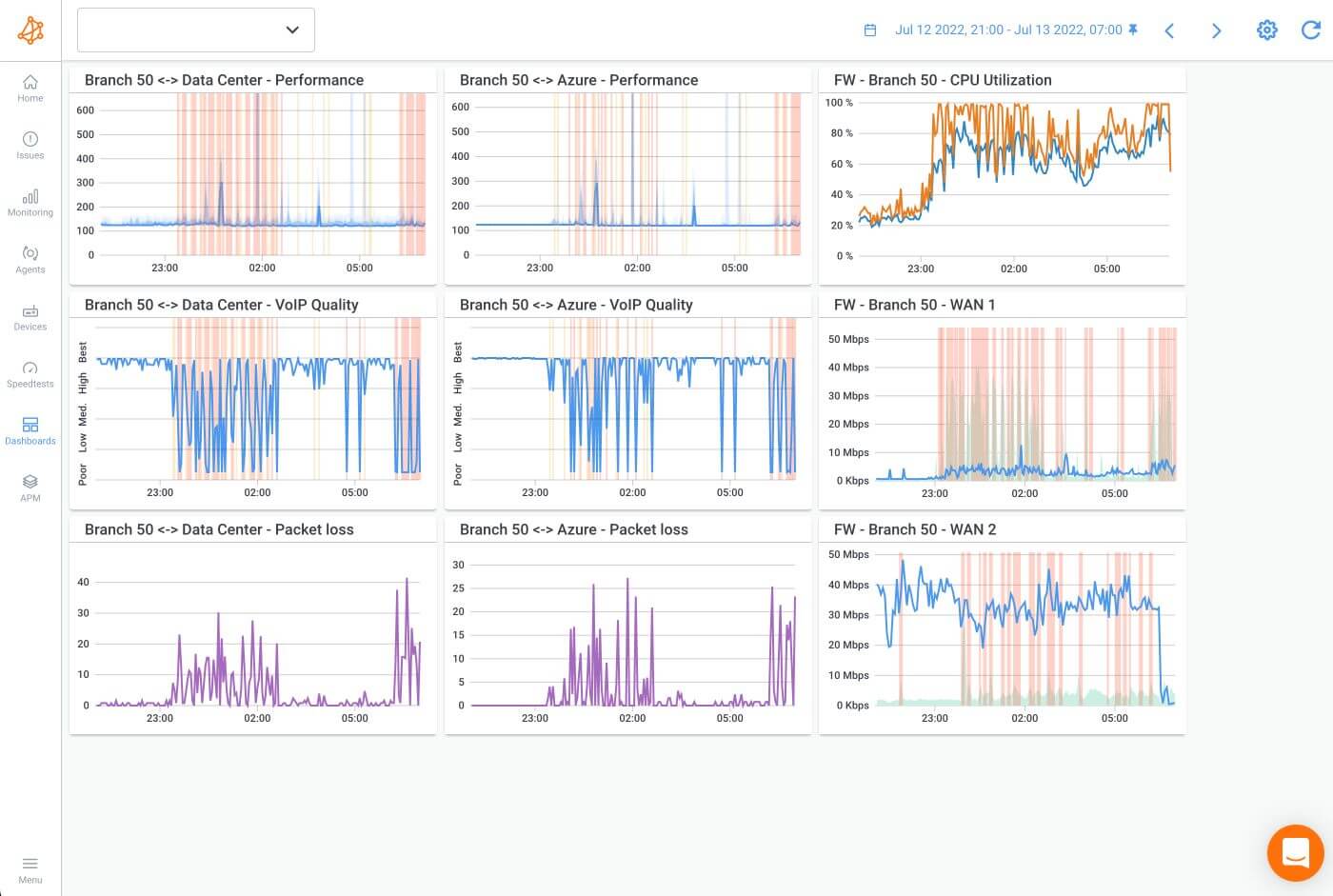
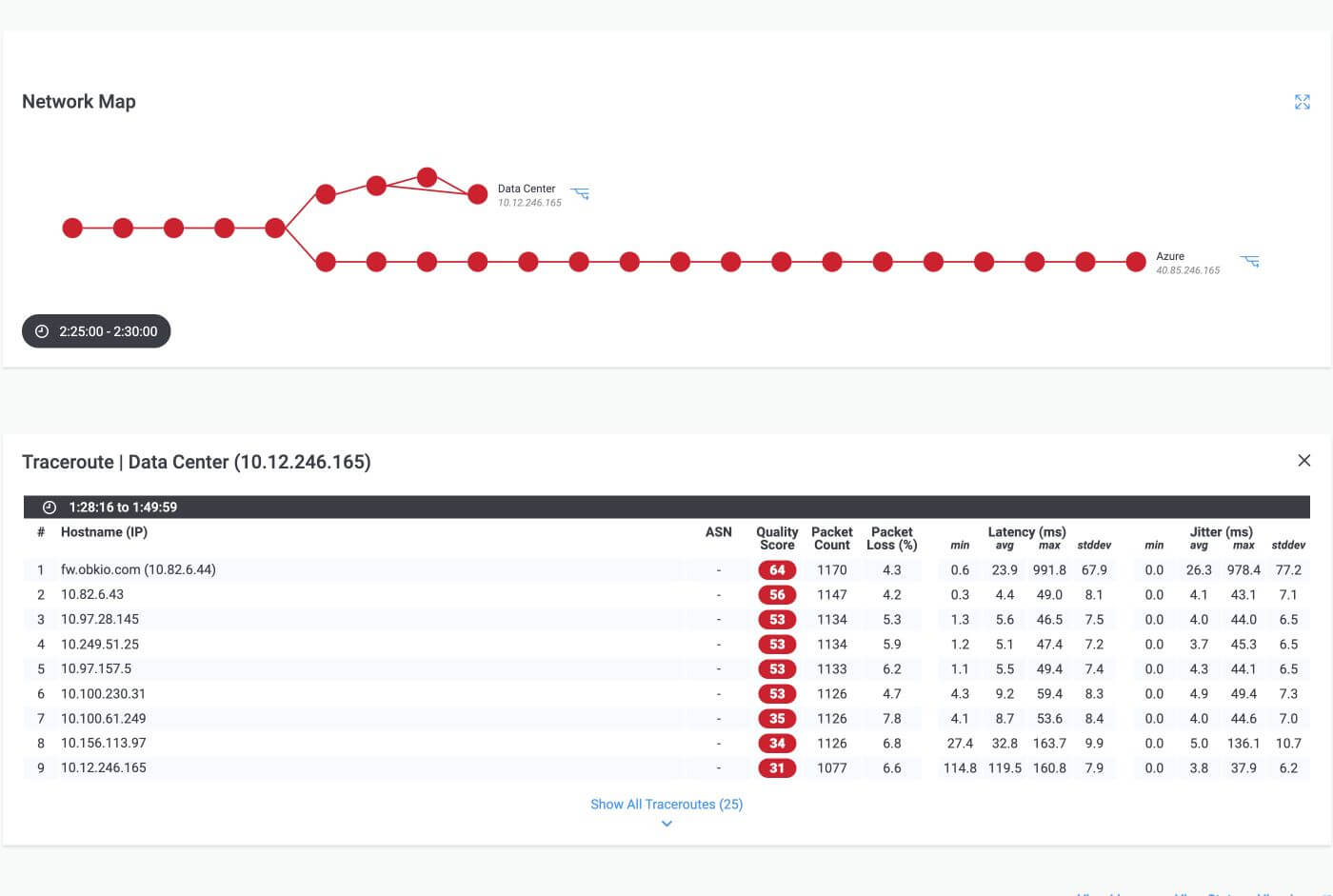
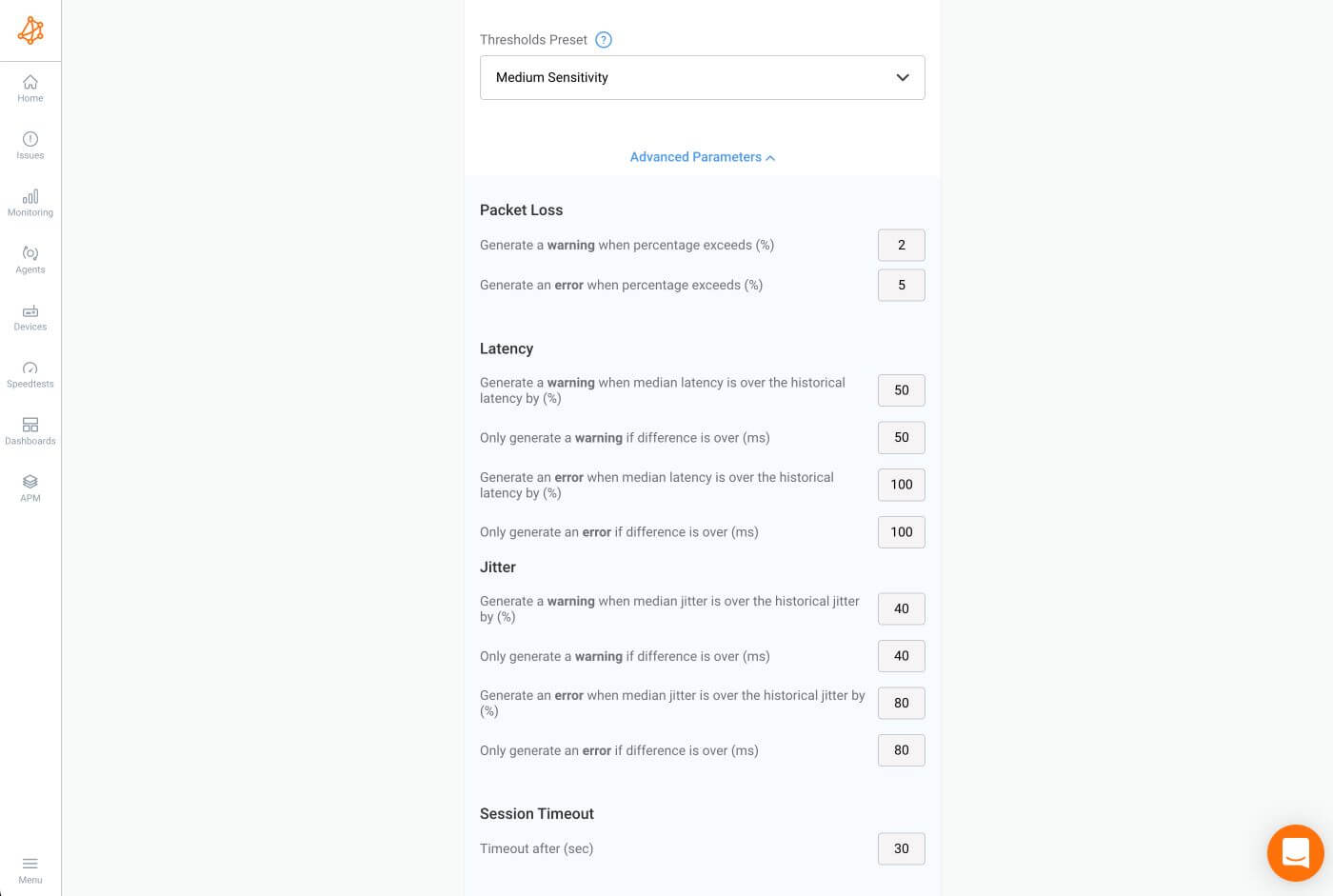
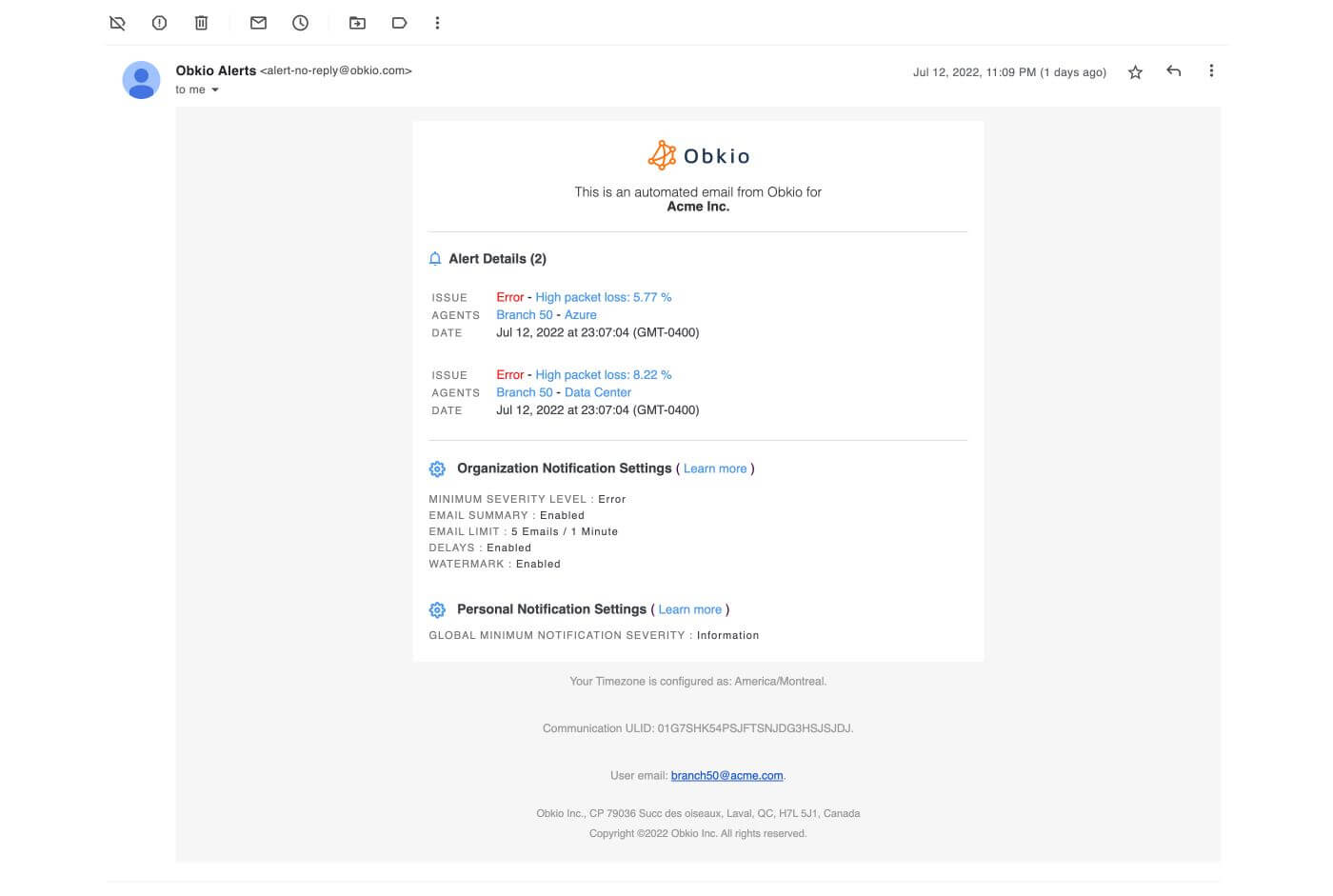
Be guided through how to identify and troubleshoot network problems with Obkio’s Network Monitoring app tour and features through screenshots.
Learn more

Obkio's Free 14-Day Trial:
To help you start monitoring and troubleshooting network connection issues in minutes, Obkio offers a free 14-day trial of all their premium features. With the help of Obkio's Onboarding Wizard, users can start collecting performance data and identifying network connection problems before your users do!
- 14-day free trial of all premium features
- Deploy in just 10 minutes
- Monitor performance in all key network locations
- Measure real-time network metrics
- Identify and troubleshoot live network problems

If you're interested in seeing Obkio's network monitoring platform in action, you can download a free 5-minute demo, or book a personalized demo or working sessions with Obkio's Network Pros!

Kentik is a network traffic intelligence platform that provides real-time network performance monitoring and analytics.
Its features include DDoS protection, network security monitoring, network performance optimization, and API integration. Kentik offers two pricing options - Essentials and Pro, which vary in included FPS, API queries/hour, dashboards, and scheduled reports.
The pricing for Kentik's Network Observability Cloud is based on the number of flow logs per second processed. Users can identify and troubleshoot network issues with Kentik's user-friendly interface.
Kentik App Interface:
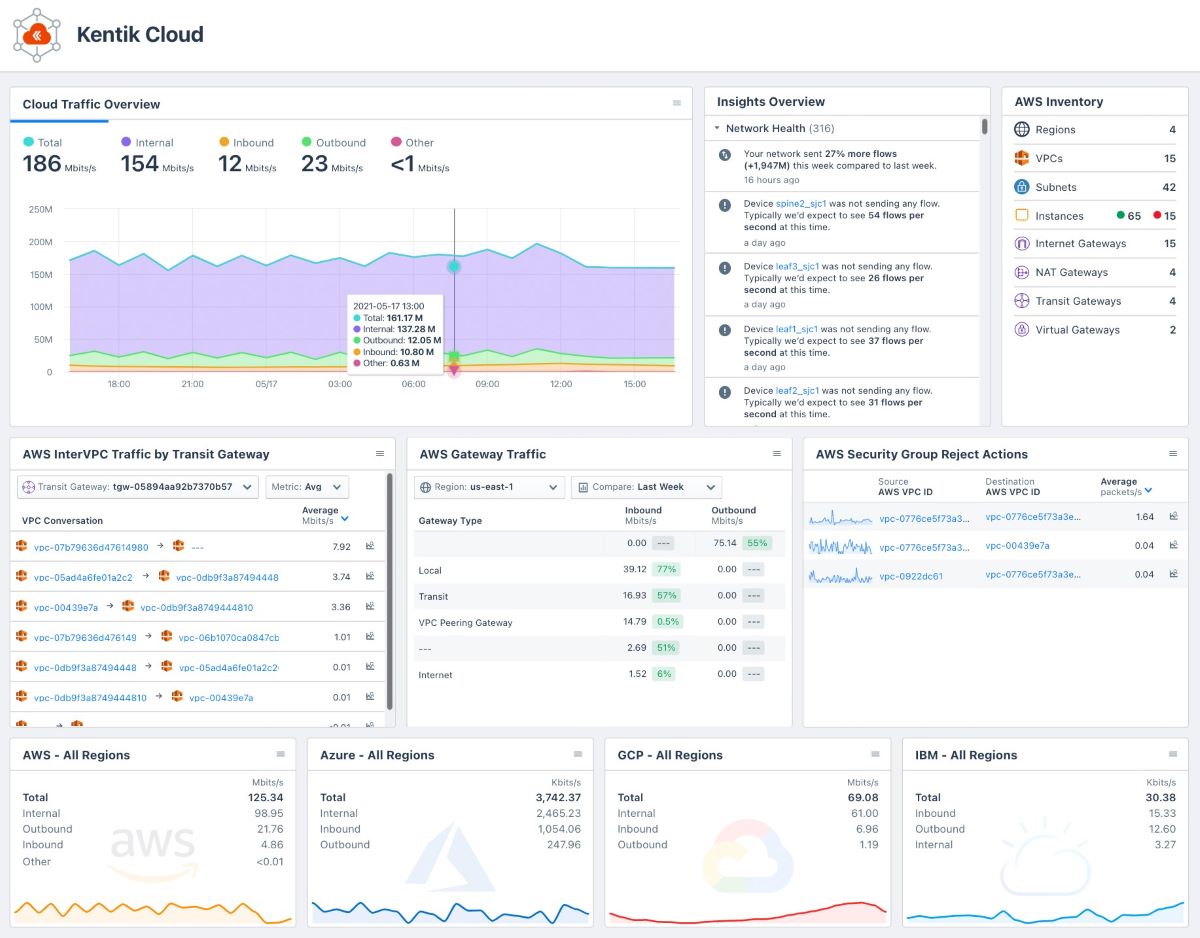
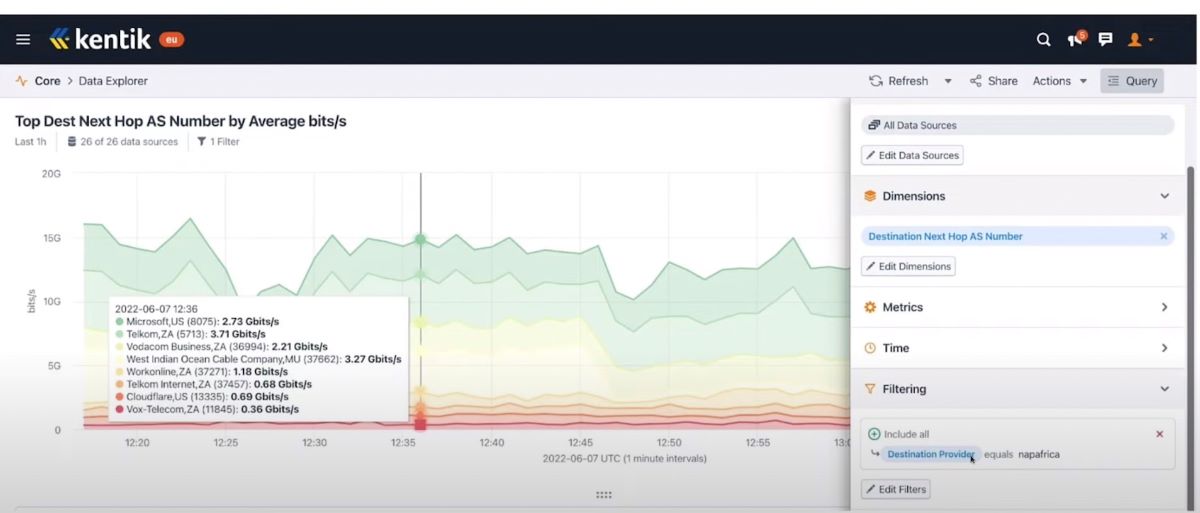
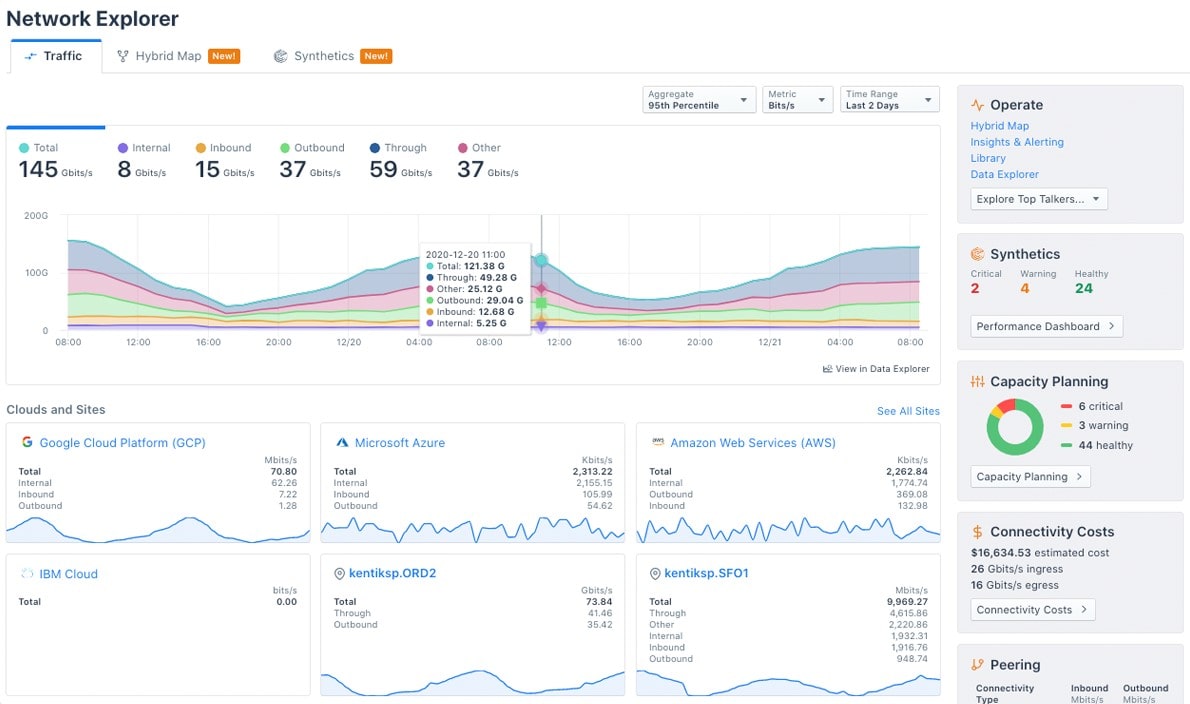
See how Obkio's Network Monitoring tool stands up against Kentik as the #1 Kentik Alternative.

ThousandEyes is a network performance monitoring tool that offers real-time monitoring and analytics for network performance, application performance, and user experience. Its key features include real-time alerts, device tracking, network topology mapping, and application performance monitoring.
ThousandEyes' interface helps users quickly identify and troubleshoot network issues.
ThousandEyes App Interface:

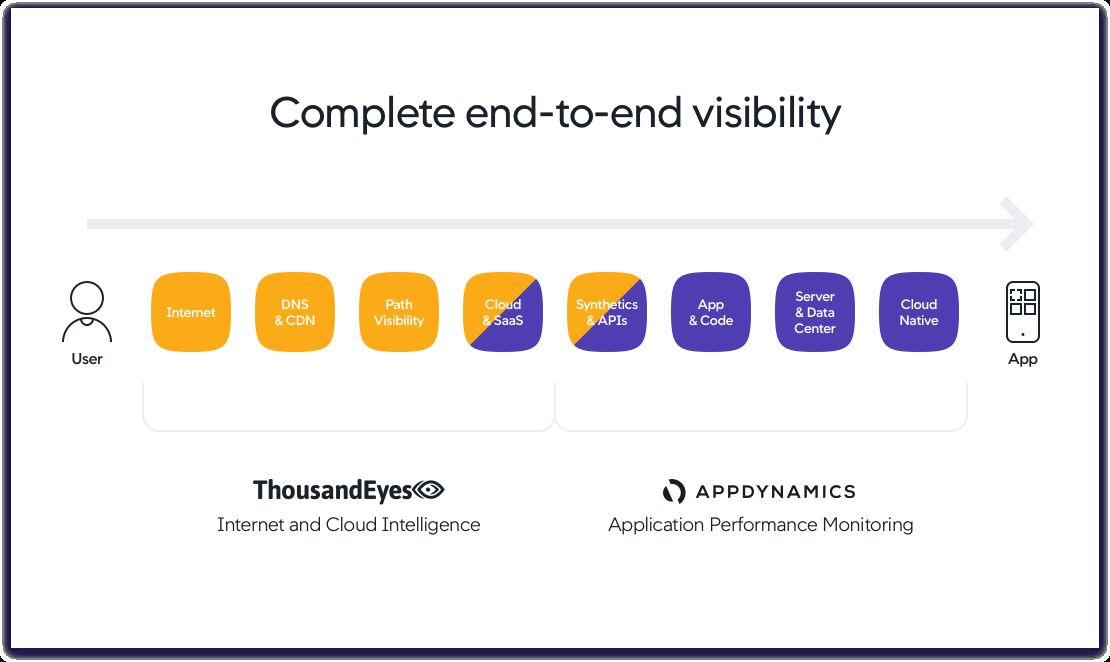
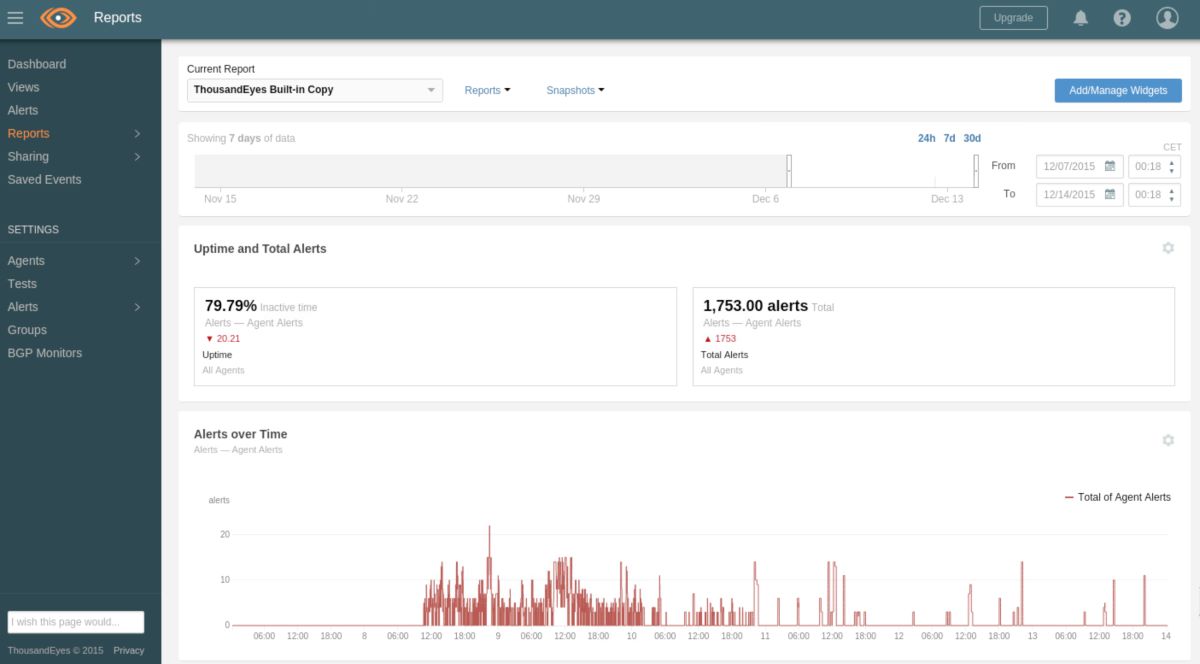
See how Obkio's Network Monitoring tool stands up against ThousandEyes as the best ThousandEyes Alternative.

Catchpoint is a network and digital experience monitoring platform that provides real-time monitoring and analytics for network performance, web performance, and user experience. Its key features include real-time alerting, device tracking, network topology mapping, and API integration.
Catchpoint's pricing options include a subscription to Catchpoint Digital Observability.
Catchpoint App Interface:
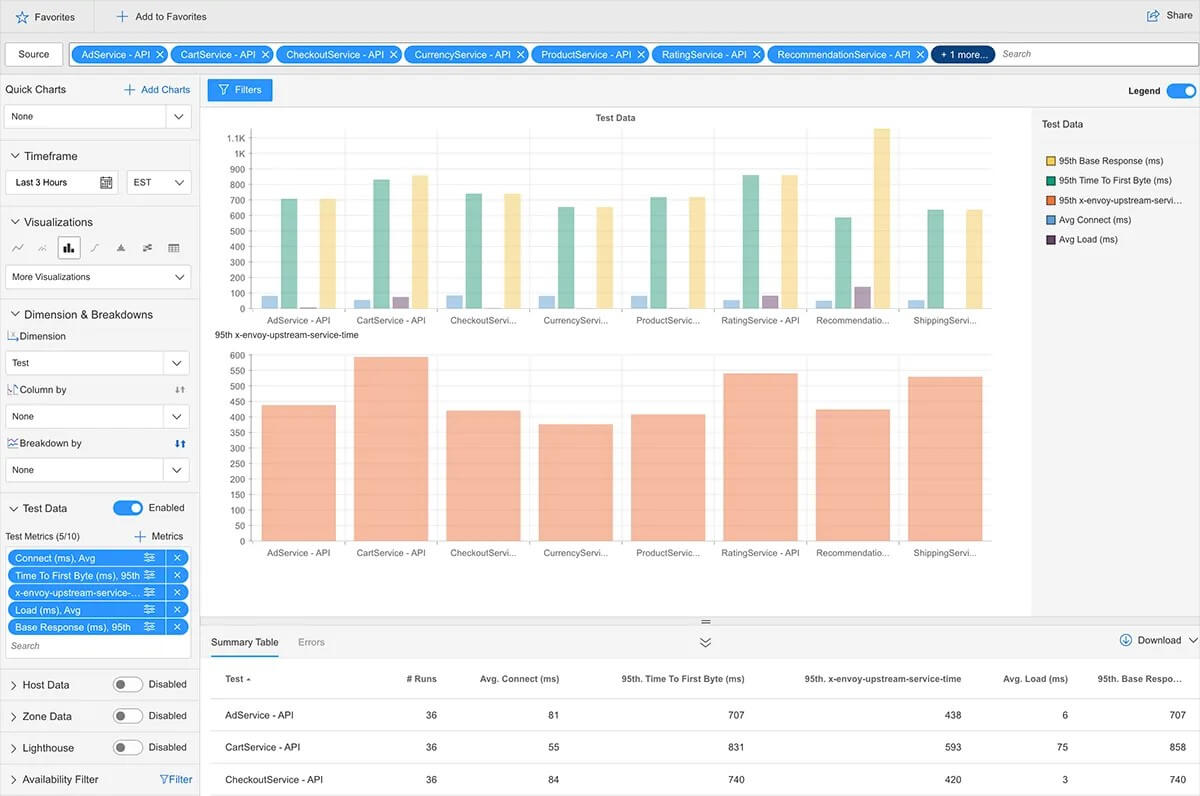
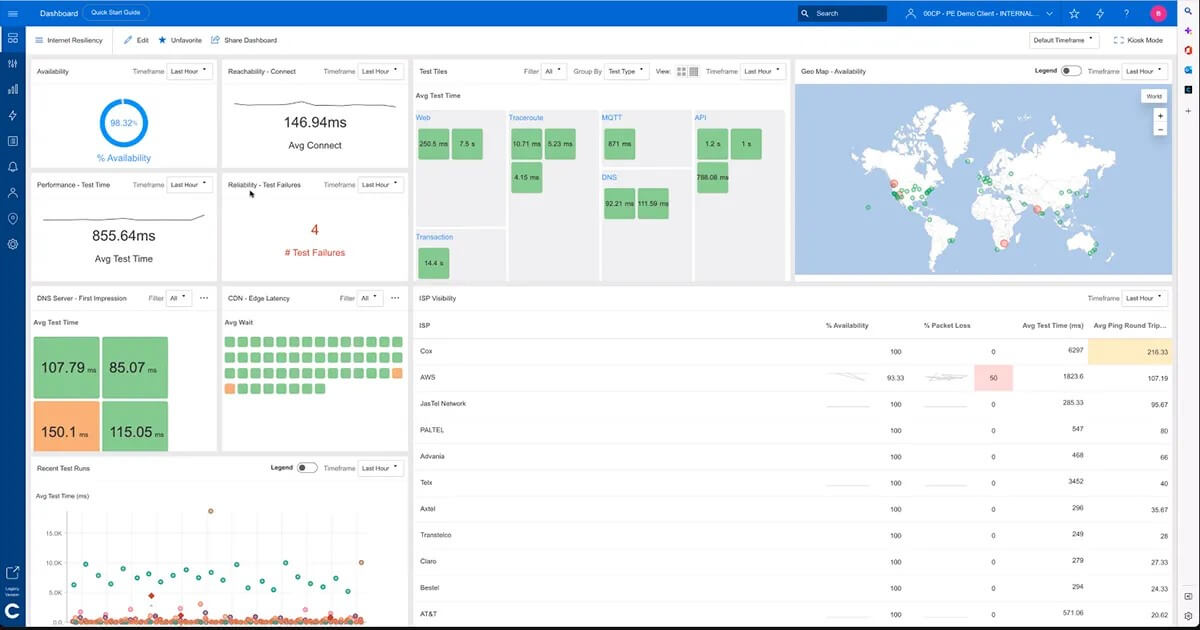
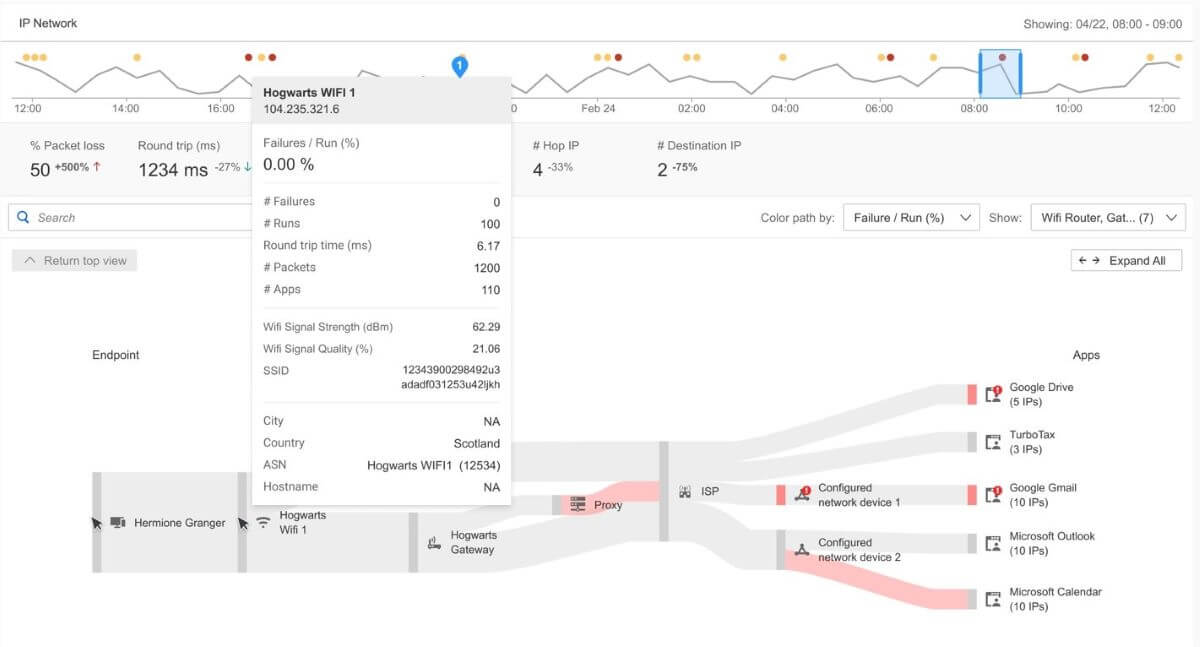
Experience the power of the Catchpoint platform in action! This demo provides an overview of Catchpoint's real-time visibility into global monitoring networks and its various platform dashboards. You'll discover how monitoring teams can leverage Catchpoint to perform synthetic tests, analyze real-time user data, and monitor full network performance to optimize the user experience.

AppNeta is a network performance monitoring tool that offers real-time monitoring and analytics for network performance and application performance. Its key features include real-time alerting, device tracking, network topology mapping, and API integration. AppNeta offers five pricing options, including Small Office, Large Office, Data Center, and two Global Monitoring options.
AppNeta App Interface
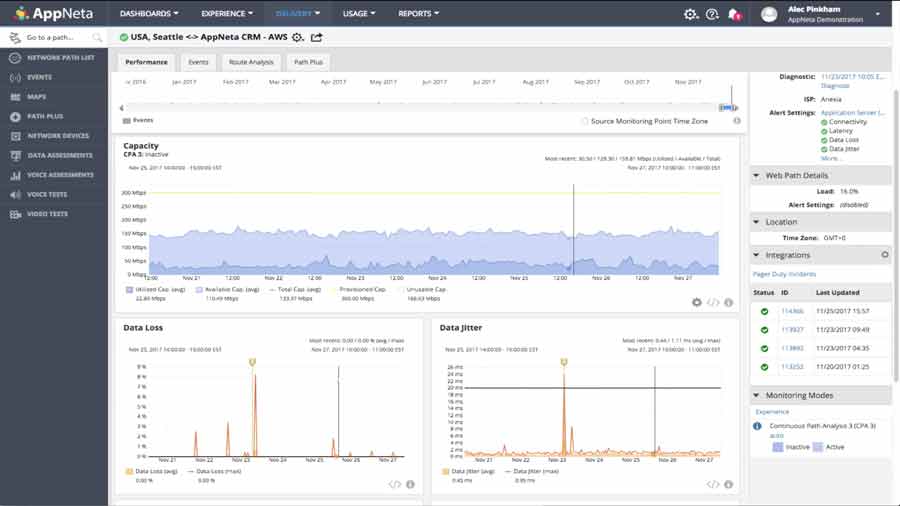
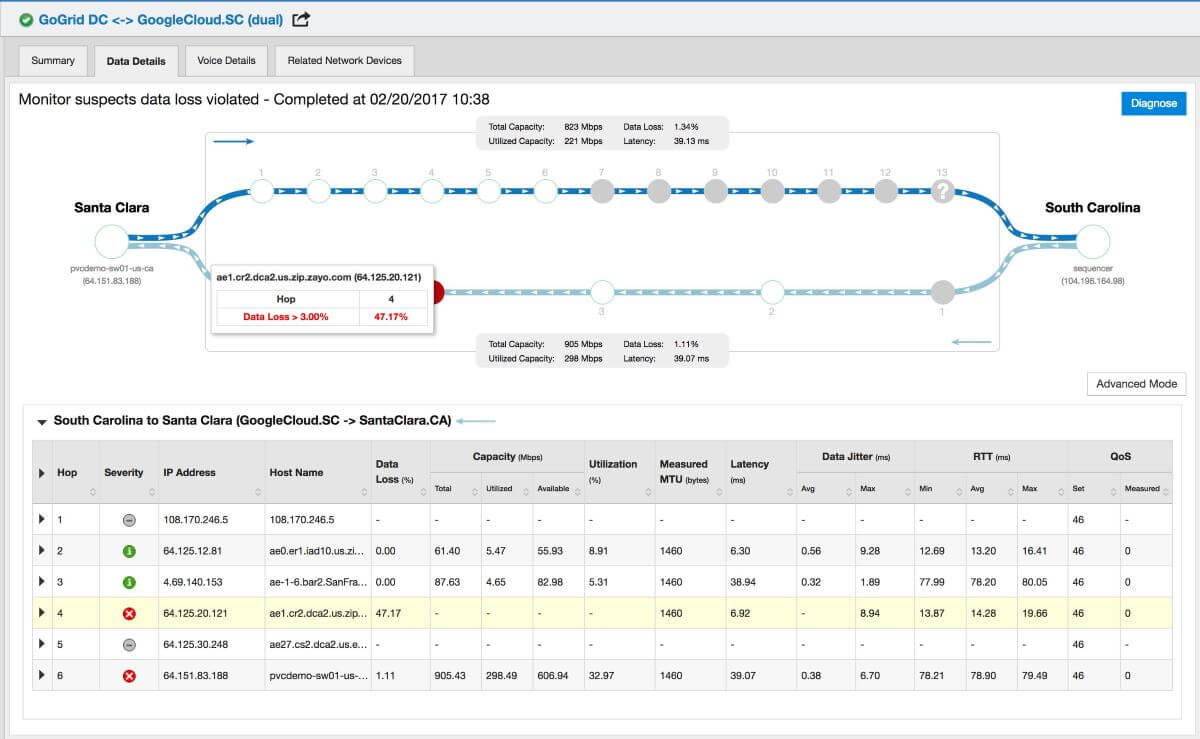
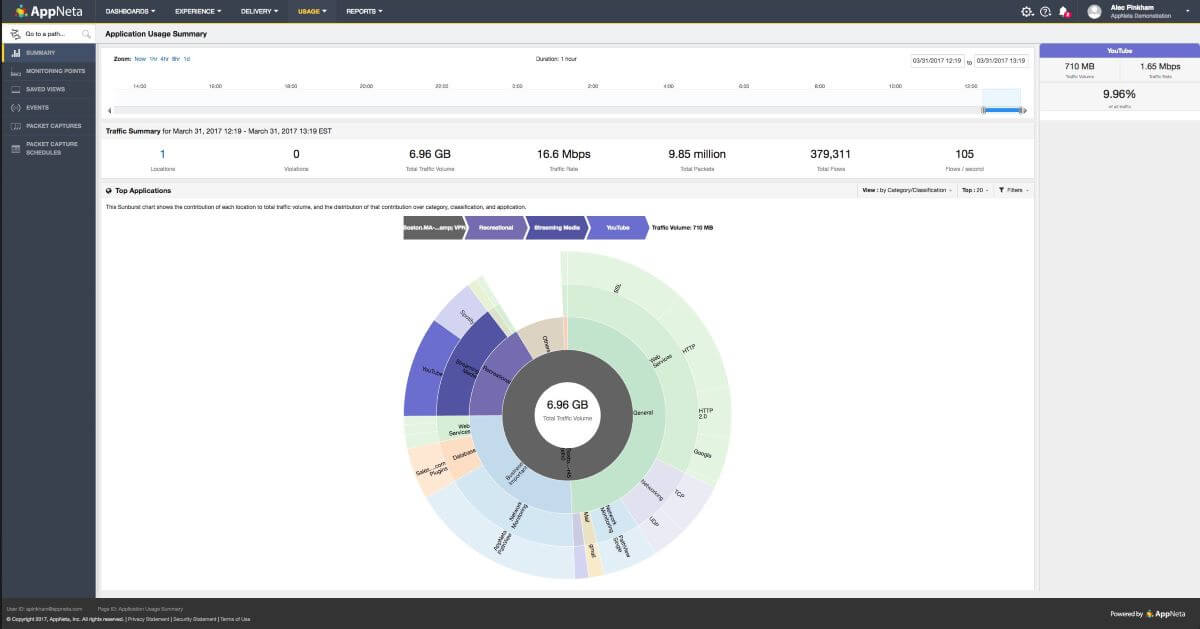
See how Obkio's Network Monitoring tool stands up against Appneta as the ultimate Appneta Alternative.

LiveAction is a network performance monitoring and diagnostics tool that provides real-time monitoring and analytics for network performance.
Its key features include real-time alerts, network topology mapping, application performance monitoring, and API integration. LiveAction offers various pricing options, including LiveNX WAN Perpetual License and LiveNX SMB Perpetual License.
LiveAction App Interface:
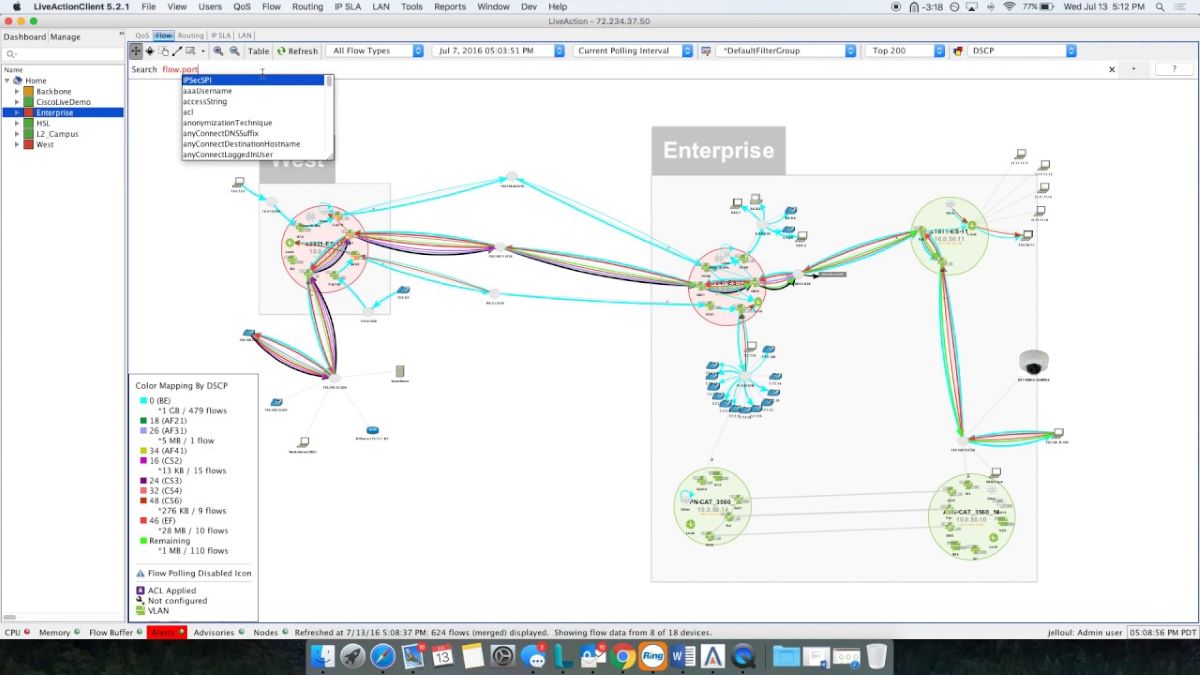
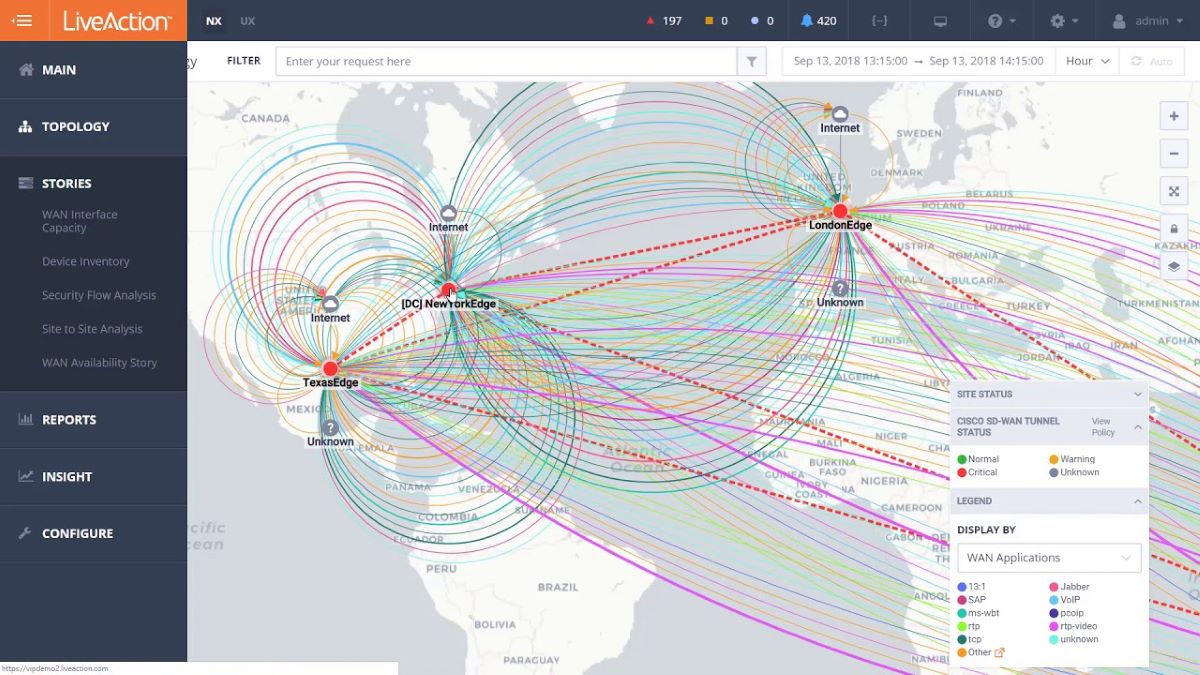
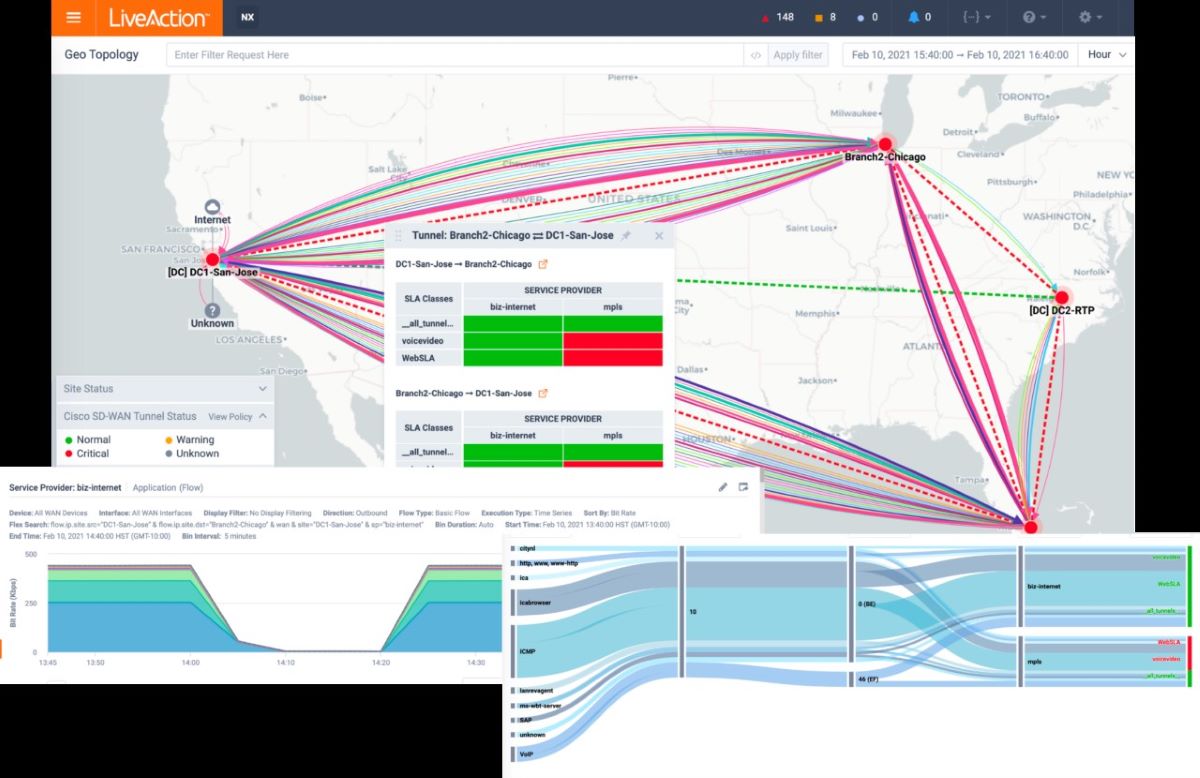

In this section, we will delve into seven traditional network connection monitoring tools. These tools focus on monitoring network traffic, collecting data from network devices, and providing insights into network health and performance. They are widely used for troubleshooting network issues, identifying security threats, and maintaining reliable network connections.
A comprehensive IT management software solution that offers network bandwidth monitoring capabilities. It provides real-time traffic analysis, bandwidth usage reports, device tracking, and more. It can monitor a variety of network devices and applications and offers customizable alerts and notifications to keep users informed of network performance issues. PRTG offers network monitoring services that allow users to monitor their network from anywhere and offers flexible deployment options.
PRTG Network Monitor offers a range of pricing options depending on the number of devices and aspects (a feature or capability within PRTG) to be monitored. For on-premise use, PRTG offers perpetual licenses for a one-time cost based on the number of aspects and devices. Additionally, maintenance licenses are available for ongoing support and updates.
PRTG App Interface:
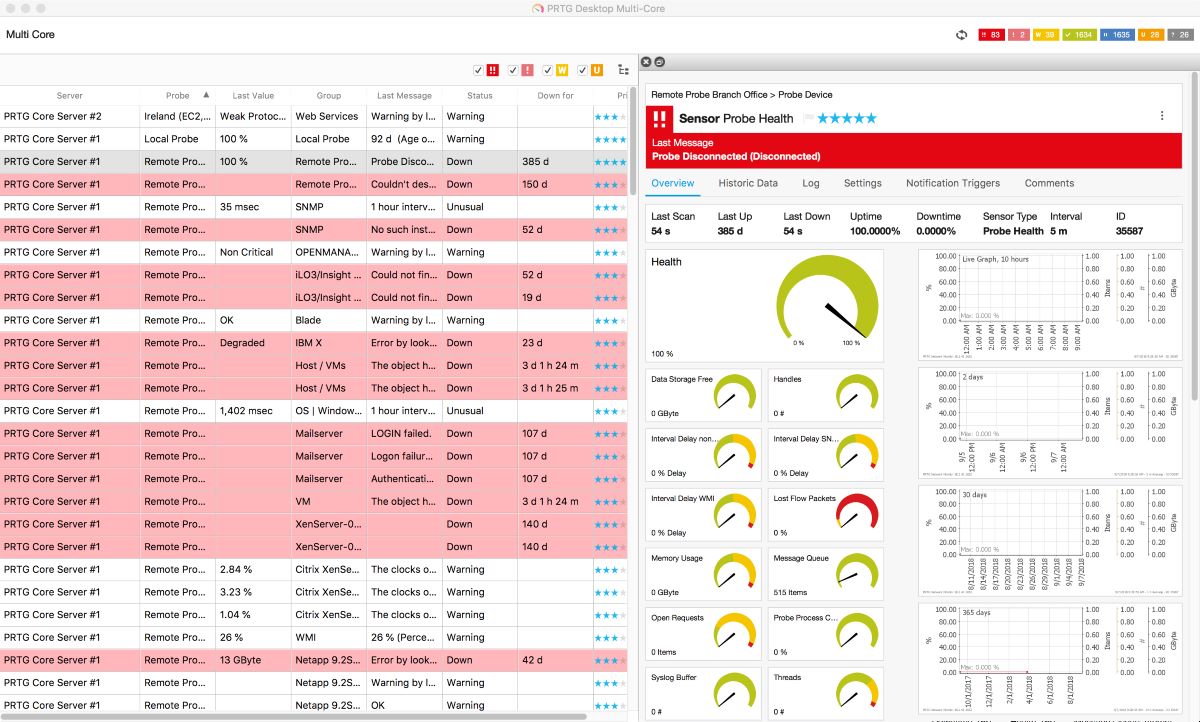

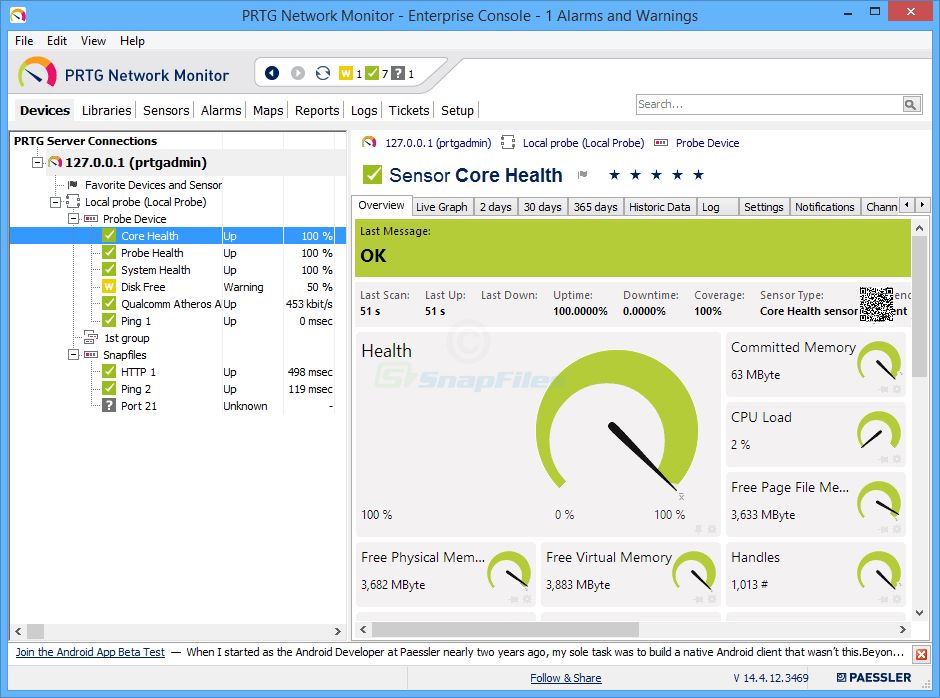

A popular IT management software solution that offers network bandwidth monitoring capabilities. It provides real-time traffic analysis, bandwidth usage reports, device tracking, and more. It can monitor a range of network devices and applications and offers customizable alerts and notifications to keep users informed of network performance issues. OPManager offers network monitoring services that allow users to monitor their network from anywhere and provides a range of deployment options, including on-premises, hosted, or as a virtual appliance.
Manage Engine OPManager offers two editions: Standard and Professional, and both editions are available in different packages based on the number of devices and users.
Manage Engine OPManager App Interface:
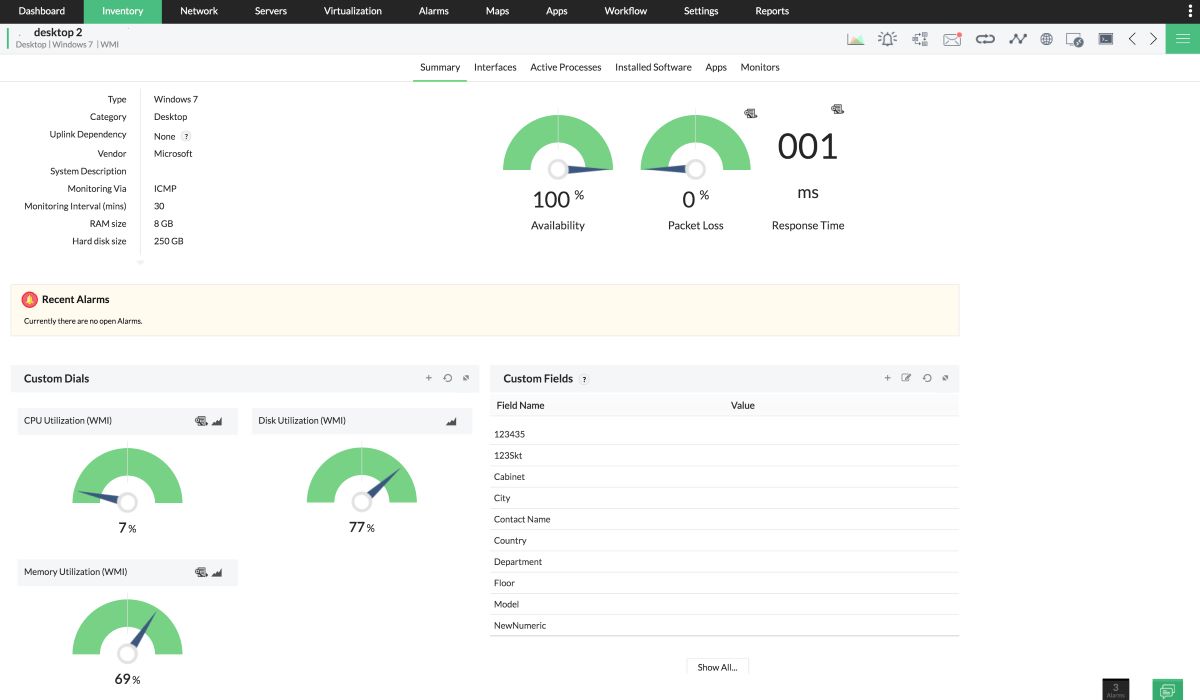

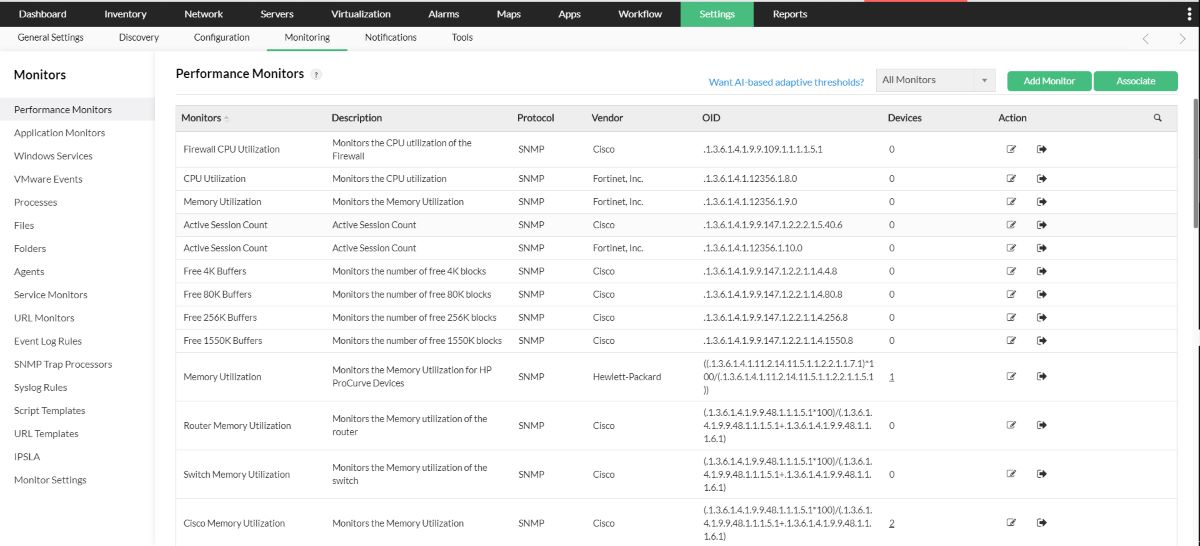

A comprehensive network performance monitoring tool that provides real-time visibility into network performance and health. It offers network device monitoring, traffic analysis, and real-time alerts and notifications to help identify and troubleshoot network issues. SolarWinds offers network monitoring services that allow users to monitor their network from anywhere and offers flexible deployment options.
SolarWinds Network Performance Monitor (NPM) is licensed based on the number of network elements being monitored, which include nodes, interfaces, and volumes.
SolarWinds App Interface:
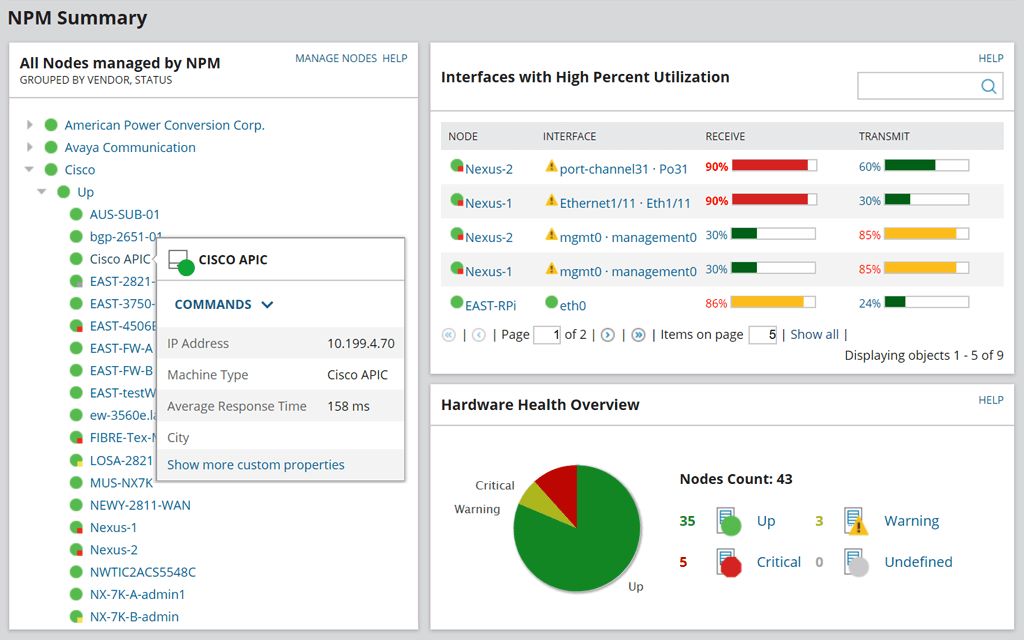
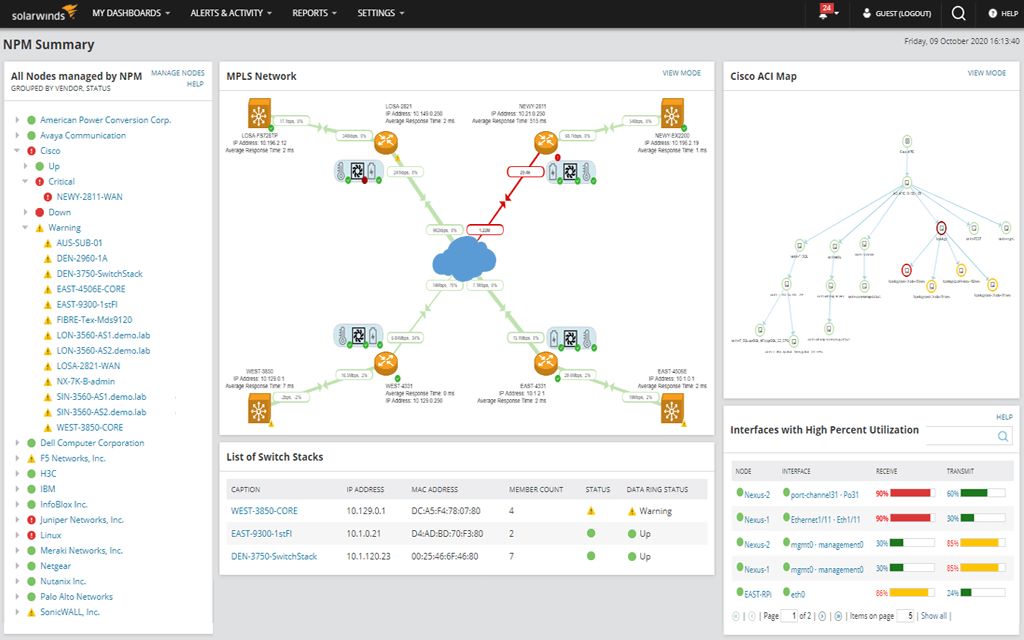
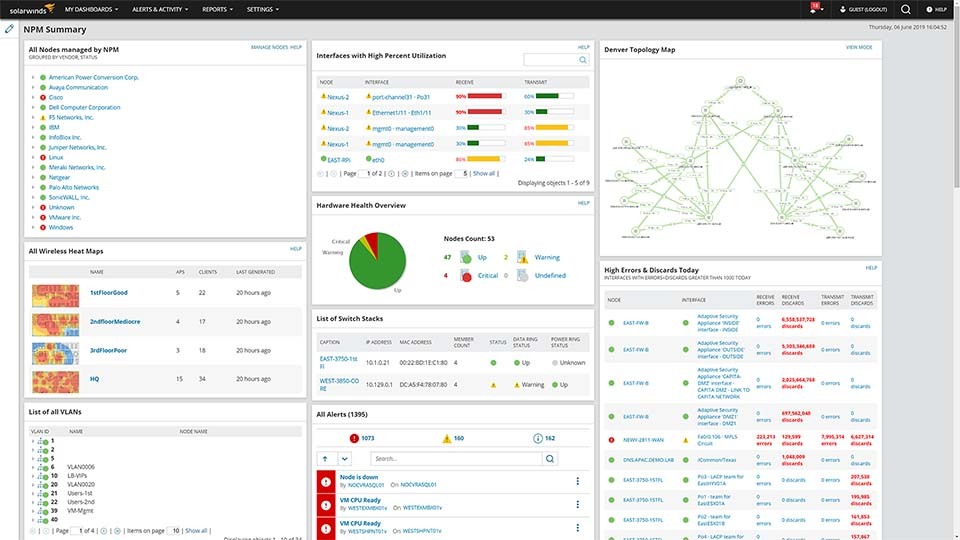
Discover how Obkio stands up against SolarWinds NPM as the simplest, most affordable SolarWinds alternative.

An IT infrastructure monitoring and management platform that offers real-time visibility into network performance, health, and security. It provides network device monitoring, traffic analysis, and customizable alerts and notifications to help identify and troubleshoot network issues. ScienceLogic offers network monitoring services that allow users to monitor their network from anywhere and provides a range of deployment options, including public and private cloud, on-premises, or hybrid.
ScienceLogic App Interface:


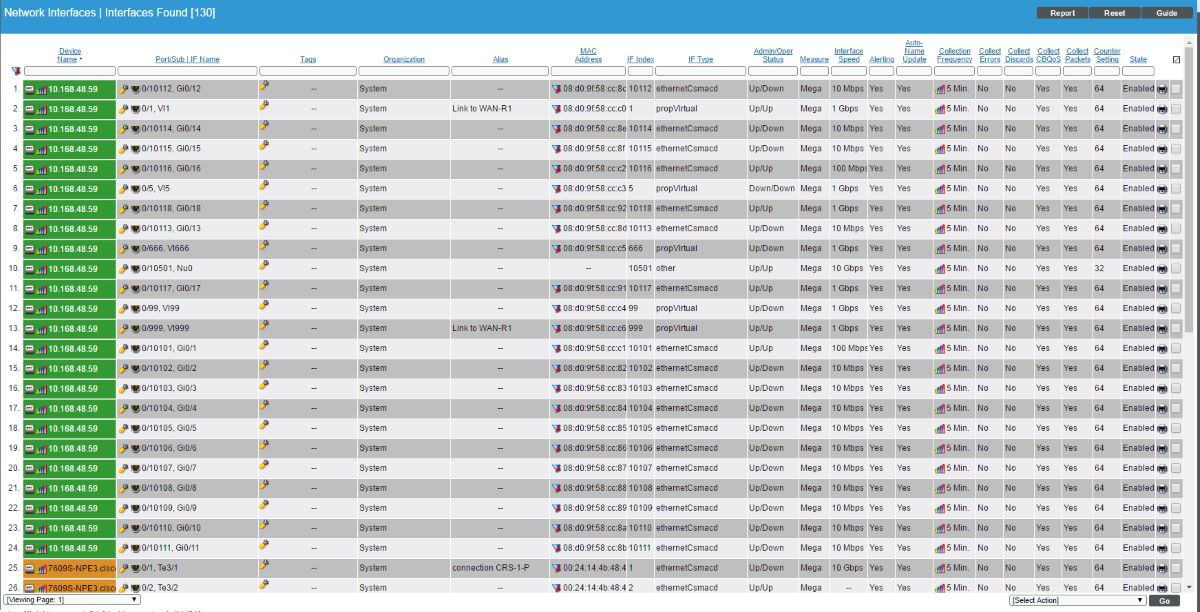
A cloud-based IT infrastructure monitoring and management platform that provides real-time visibility into network performance and health. It offers network device monitoring, traffic analysis, and real-time alerts and notifications to help identify and troubleshoot network issues. LogicMonitor offers network monitoring services that allow users to monitor their network from anywhere and provides a range of deployment options, including public and private cloud, on-premises, or hybrid.
LogicMonitor's pricing is based on the number of monitored devices. The cost per device per month decreases as the number of devices being monitored increases.
LogicMonitor App Interface:
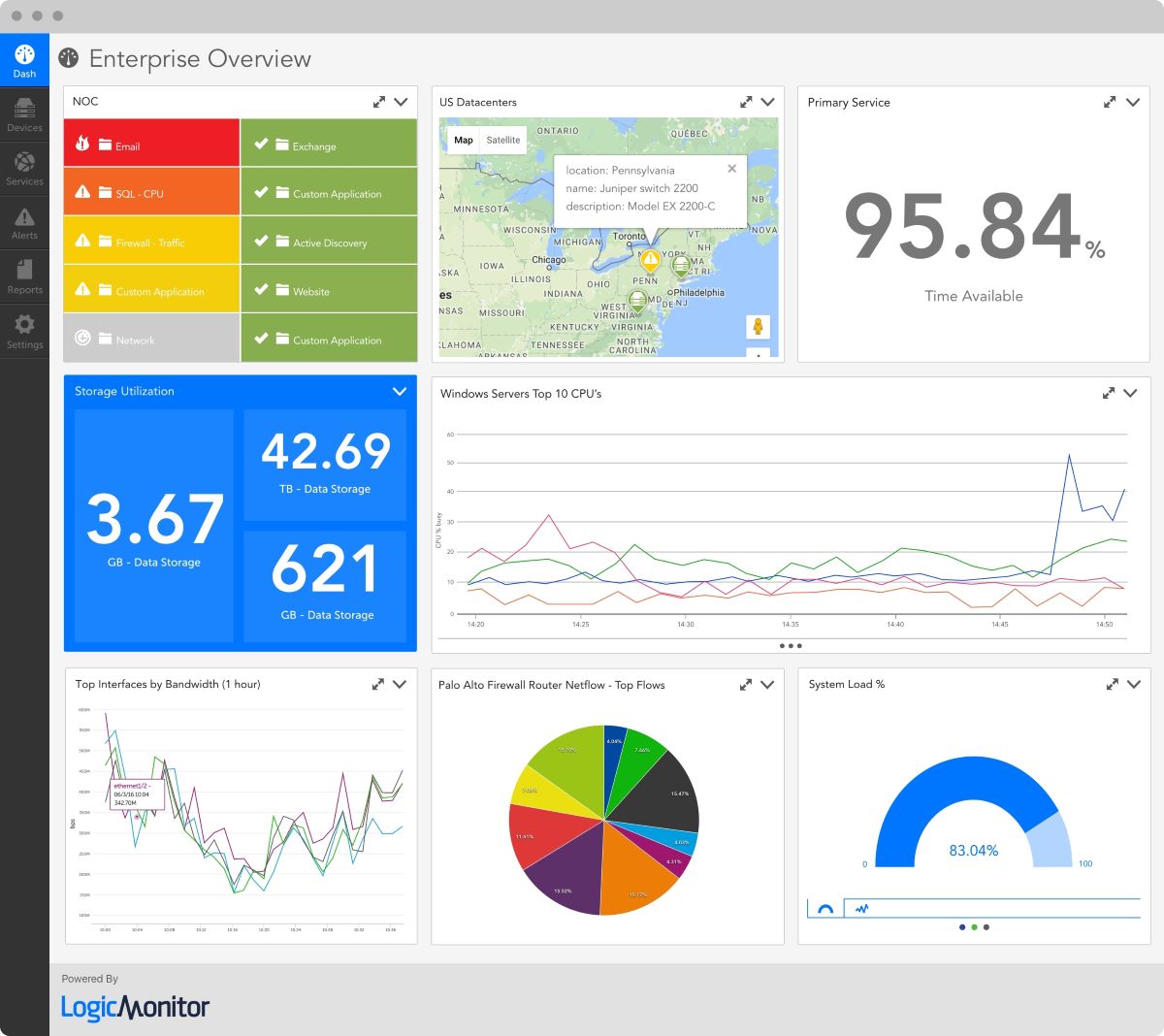
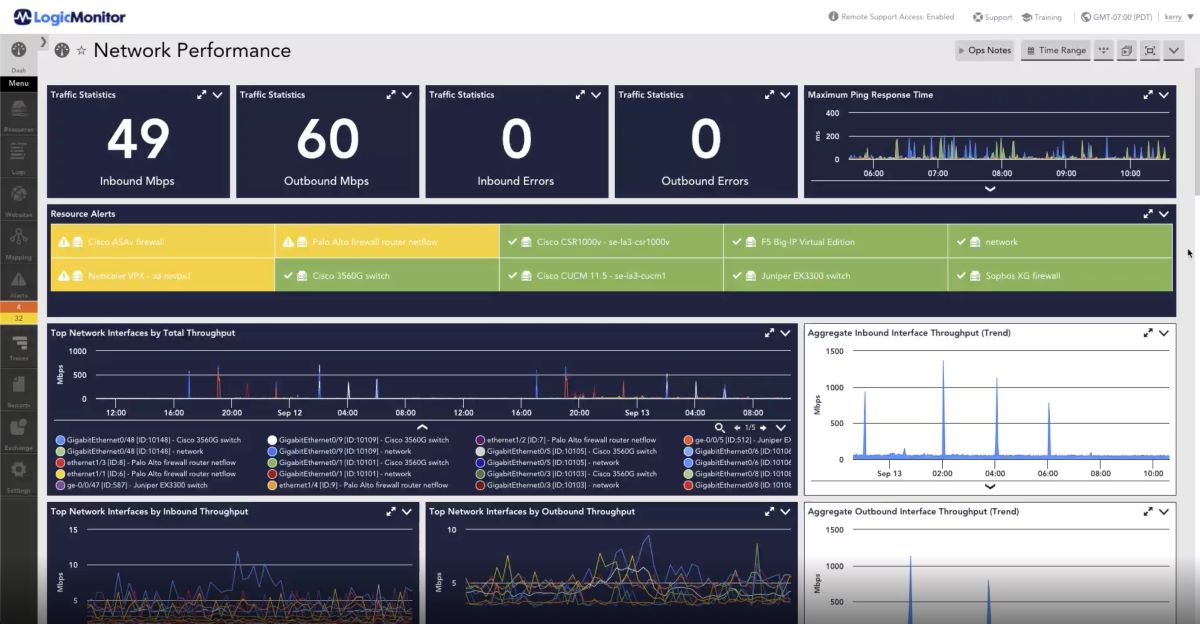
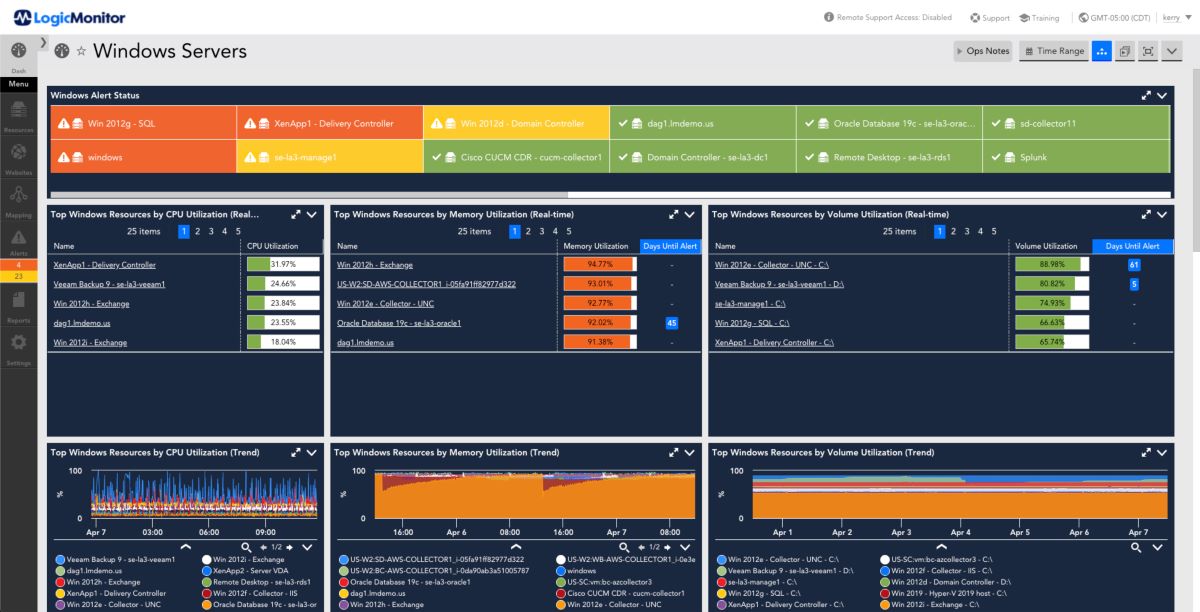

A network monitoring and management tool that provides real-time visibility into network performance, health, and security. It offers network device monitoring, traffic analysis, and customizable alerts and notifications to help identify and troubleshoot network issues. Auvik offers network monitoring services that allow users to monitor their network from anywhere and provides a range of deployment options, including public and private cloud, on-premises, or hybrid.
Auvik offers two pricing plans for its network monitoring services: Basic and Performance. .
Auvik App Interface:
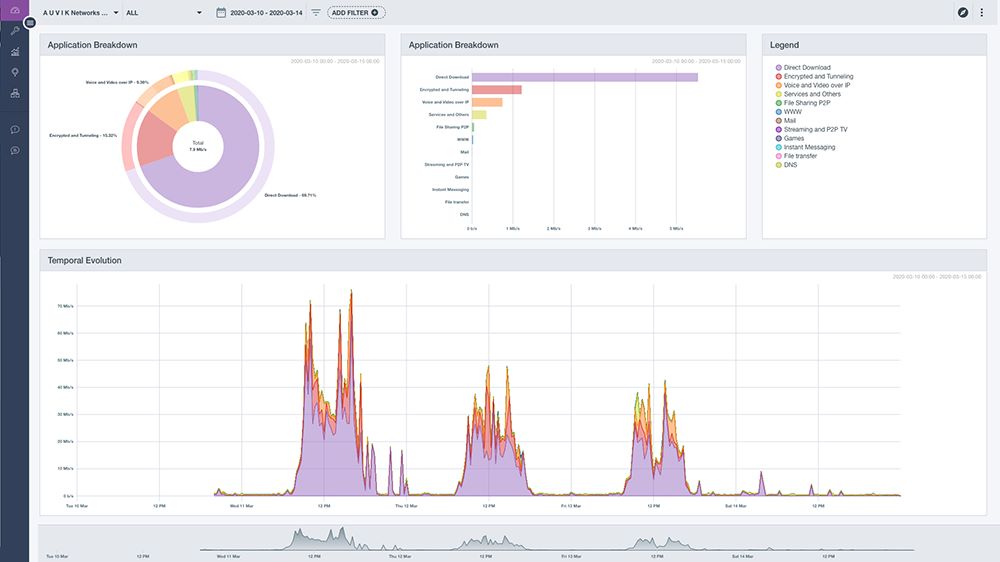
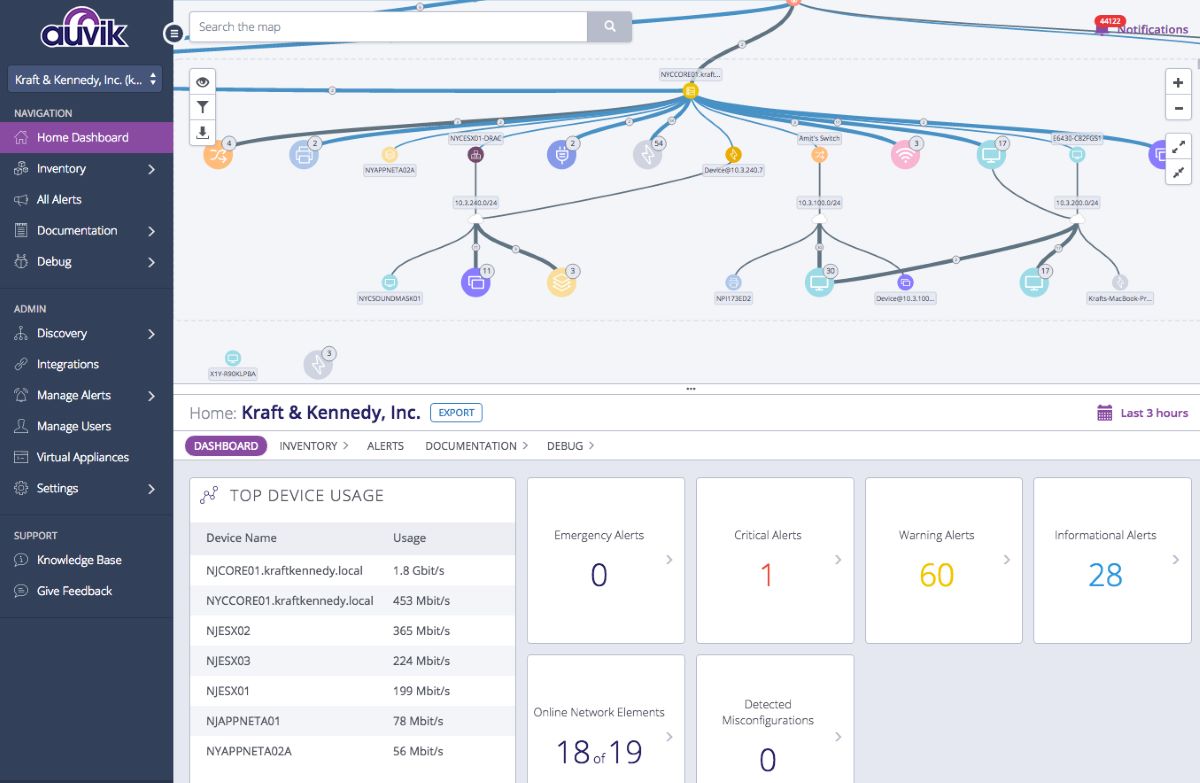
An open-source network monitoring and management tool that provides real-time visibility into network performance and health. It offers network device monitoring, traffic analysis, and customizable alerts and notifications to help identify and troubleshoot network issues. Icinga offers network monitoring services that allow users to monitor their network from anywhere and provides a range of deployment options, including public and private cloud, on-premises, or hybrid.
Icinga is a free and open-source network monitoring solution. However, in 2022, Icinga announced that it would move to a subscription-based model for Red Hat Enterprise Linux, SUSE Linux Enterprise Server, and Amazon Linux. Users can still build the agent for free, and the subscription is only required for non-community Linuxes and the official packages.
Icinga App Interface:




An IT infrastructure monitoring and management platform that offers network device monitoring, traffic analysis, and customizable alerts and notifications to help identify and troubleshoot network issues. It provides real-time visibility into network performance and health and offers network monitoring services that allow users to monitor their network from anywhere and provides a range of deployment options, including public and private cloud, on-premises, or hybrid.
Progress WhatsUp Gold does not publicly disclose their pricing information on their website.
Progress WhatsUpGoldUser App Interface:
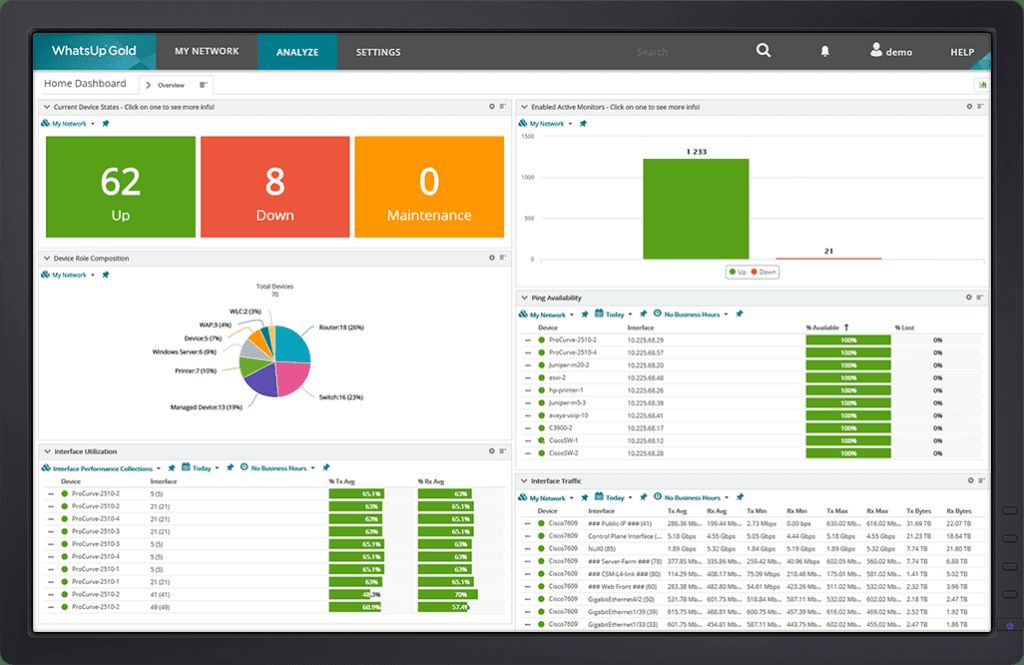
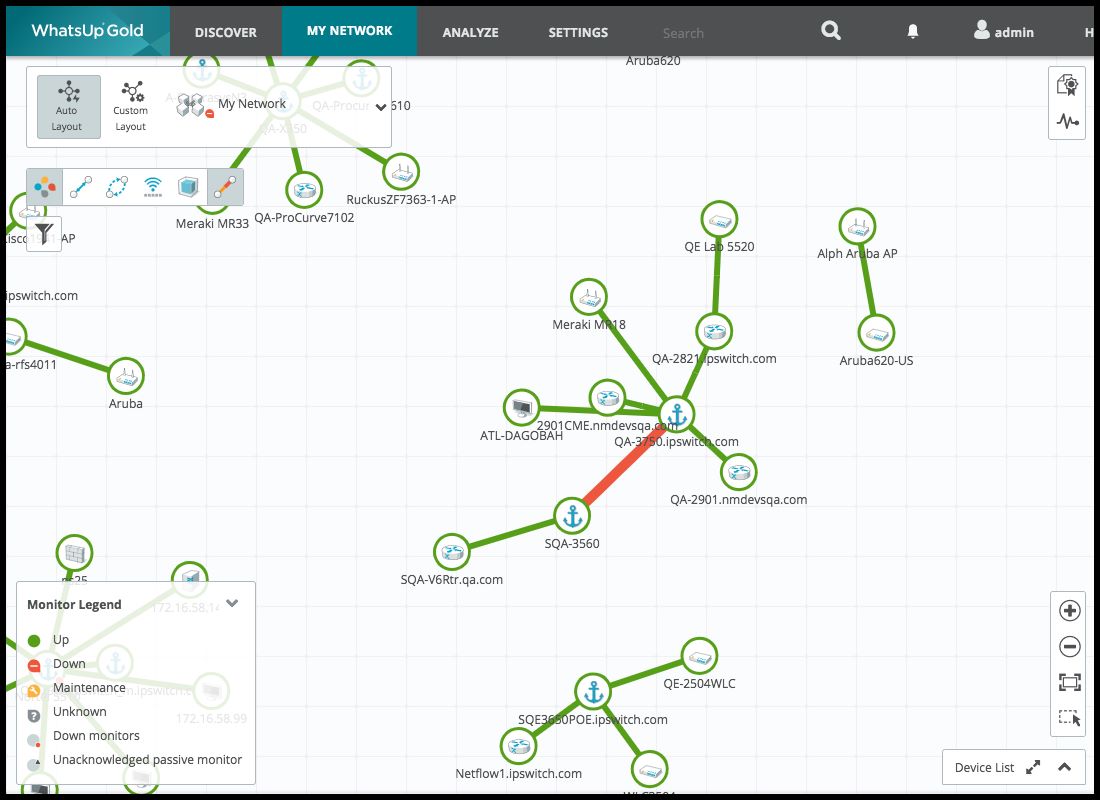
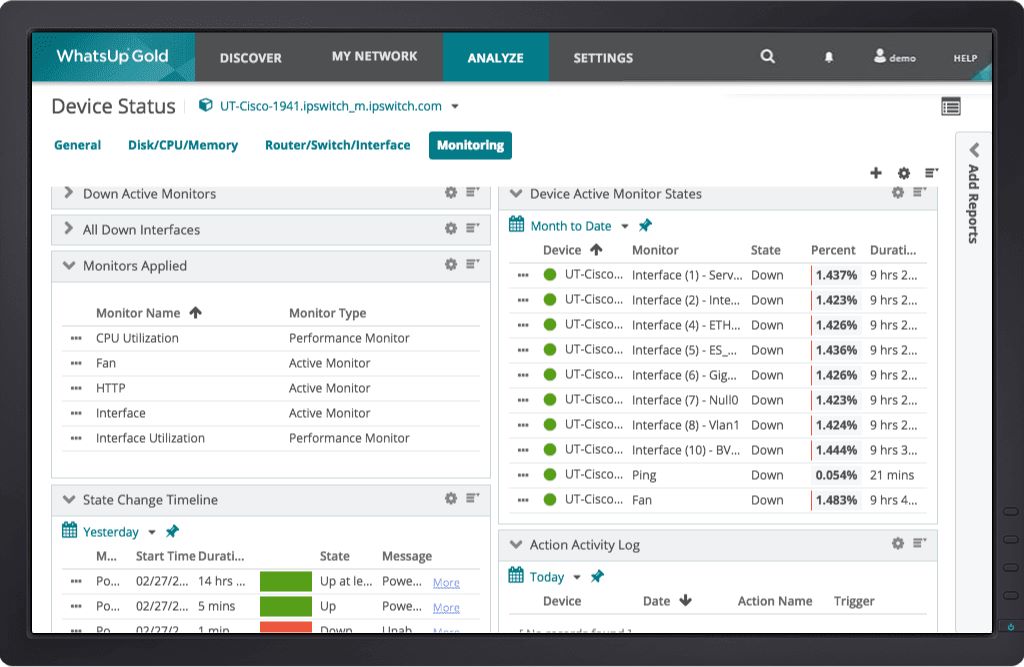

In this section, we will explore five open-source network monitoring tools or free network connection monitoring tools. These tools offer a cost-effective alternative for organizations seeking robust network monitoring capabilities. With features like network discovery, device monitoring, and bandwidth analysis, these tools provide valuable insights into network connectivity without requiring a significant investment.
Nagios XI is a popular IT infrastructure monitoring solution that provides comprehensive monitoring capabilities for networks, systems, and applications. It offers real-time alerting, reporting, and customizable dashboards to help users quickly identify and resolve issues. Nagios XI also includes cloud monitoring capabilities, allowing users to monitor cloud-based infrastructure, such as AWS and Azure, along with on-premises infrastructure. It provides insights into cloud resource usage, performance, and availability, and supports monitoring of cloud services such as RDS, S3, and EC2.
Nagios XI is free for up to 7 nodes after the trial. Nagios XI also offers add-ons such as Nagios Log Server, Nagios Network Analyzer, and Nagios Fusion, which can be purchased separately.
Nagios XI App Interface:
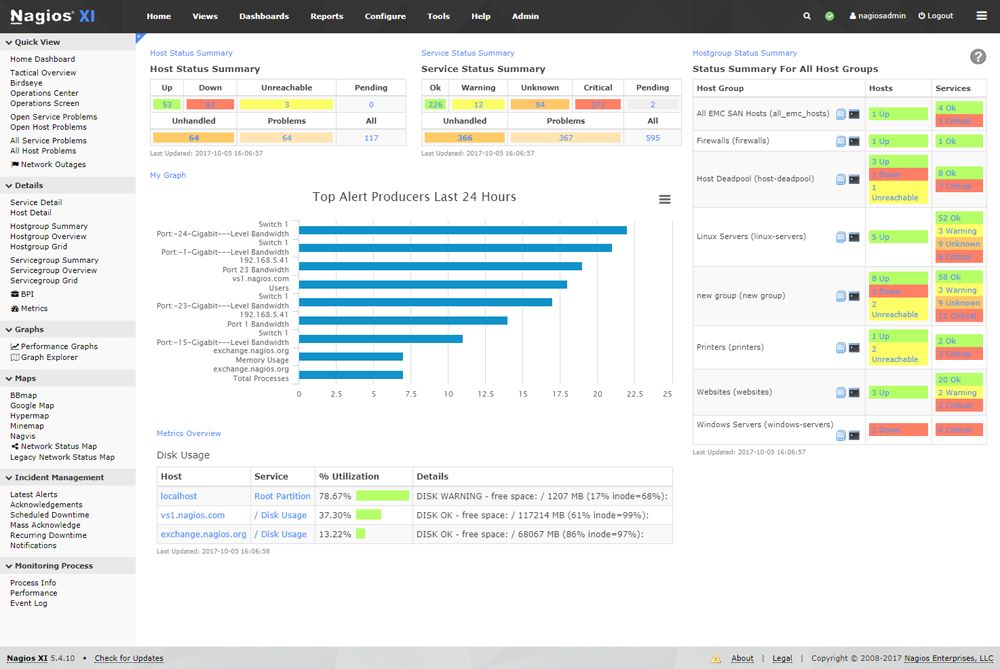
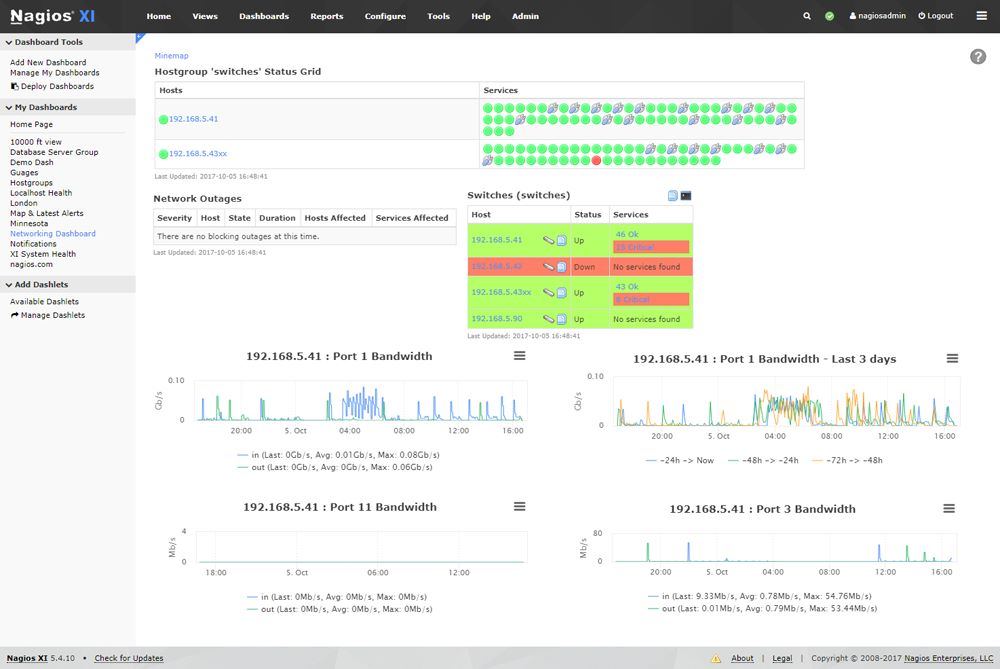
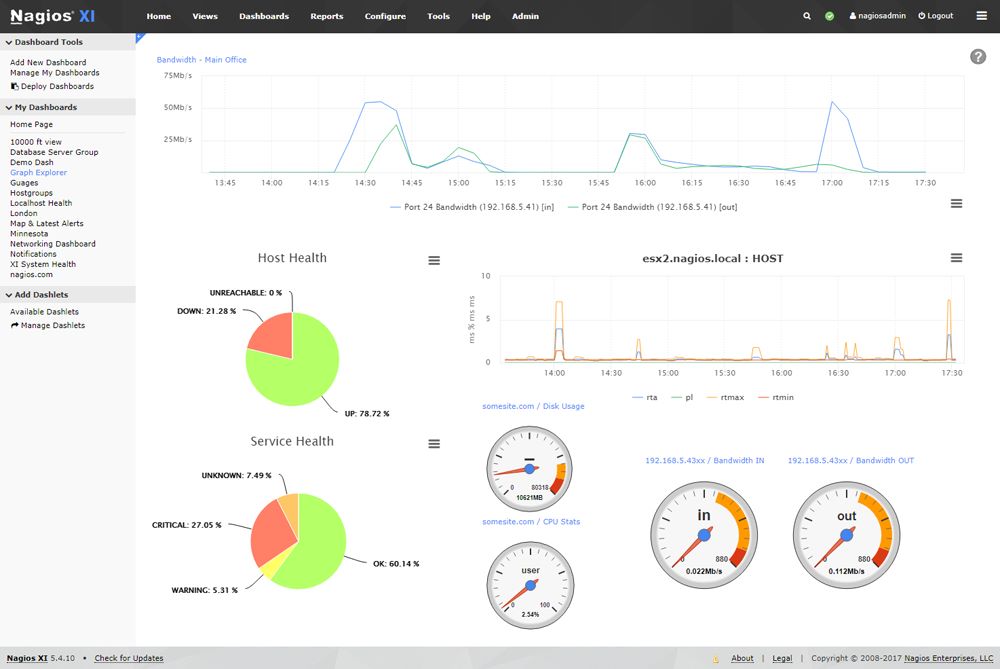

LibreNMS is a free and open-source network monitoring solution that provides auto-discovery, alerting, and reporting capabilities. It offers support for a wide range of devices and network monitoring protocols, including SNMP, syslog, and ICMP. LibreNMS also includes cloud monitoring capabilities, allowing users to monitor cloud-based infrastructure, such as AWS and Azure, along with on-premises infrastructure. It provides insights into cloud resource usage, performance, and availability, and supports monitoring of cloud services such as EC2 and RDS.
LibreNMS is open source and available for free to download and use. However, some resellers offer pre configured and managed versions of the tool at a price.
LibreNMS App Interface:
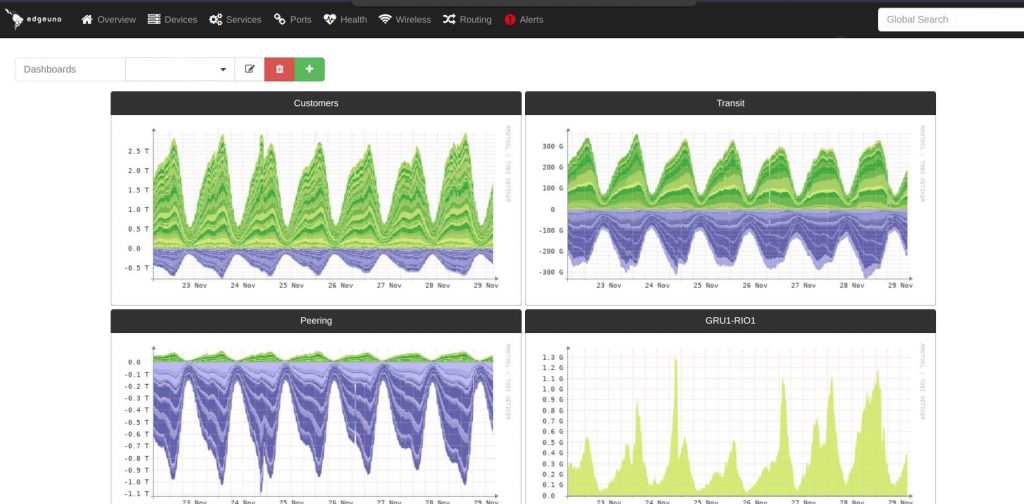
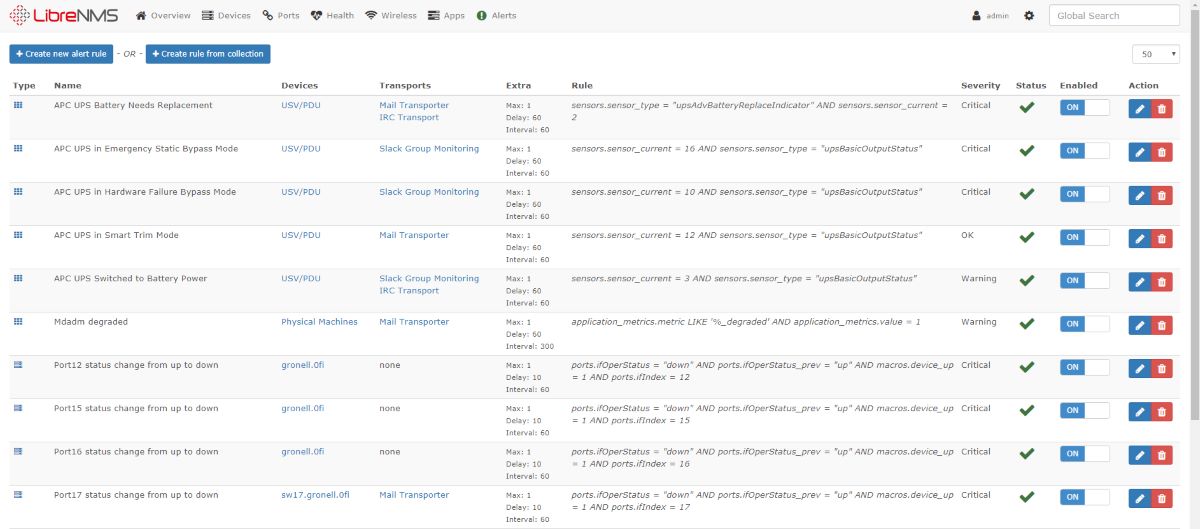
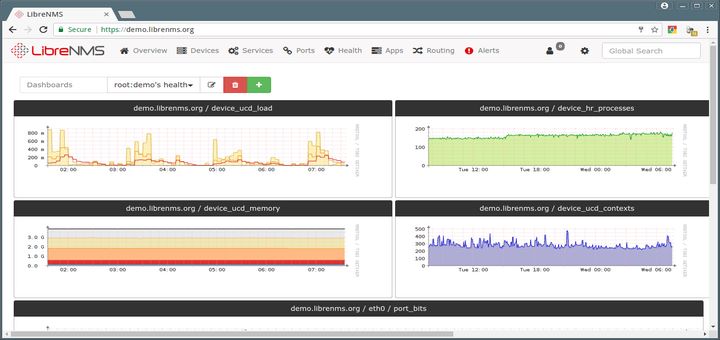

Zabbix is an enterprise-grade monitoring solution that offers a wide range of monitoring capabilities, including network, server, and application monitoring. It provides real-time alerting, reporting, and customizable dashboards to help users quickly identify and resolve issues. Zabbix also includes cloud monitoring capabilities, allowing users to monitor cloud-based infrastructure, such as AWS and Azure, along with on-premises infrastructure. It provides insights into cloud resource usage, performance, and availability, and supports monitoring of cloud services such as EC2, RDS, and ELB.
Zabbix is released under the GPL license, thus is free for commercial and non-commercial use. There are no limitations on the number of monitored devices, you can use Zabbix to monitor many thousands of devices absolutely free.
Zabbix App Interface:
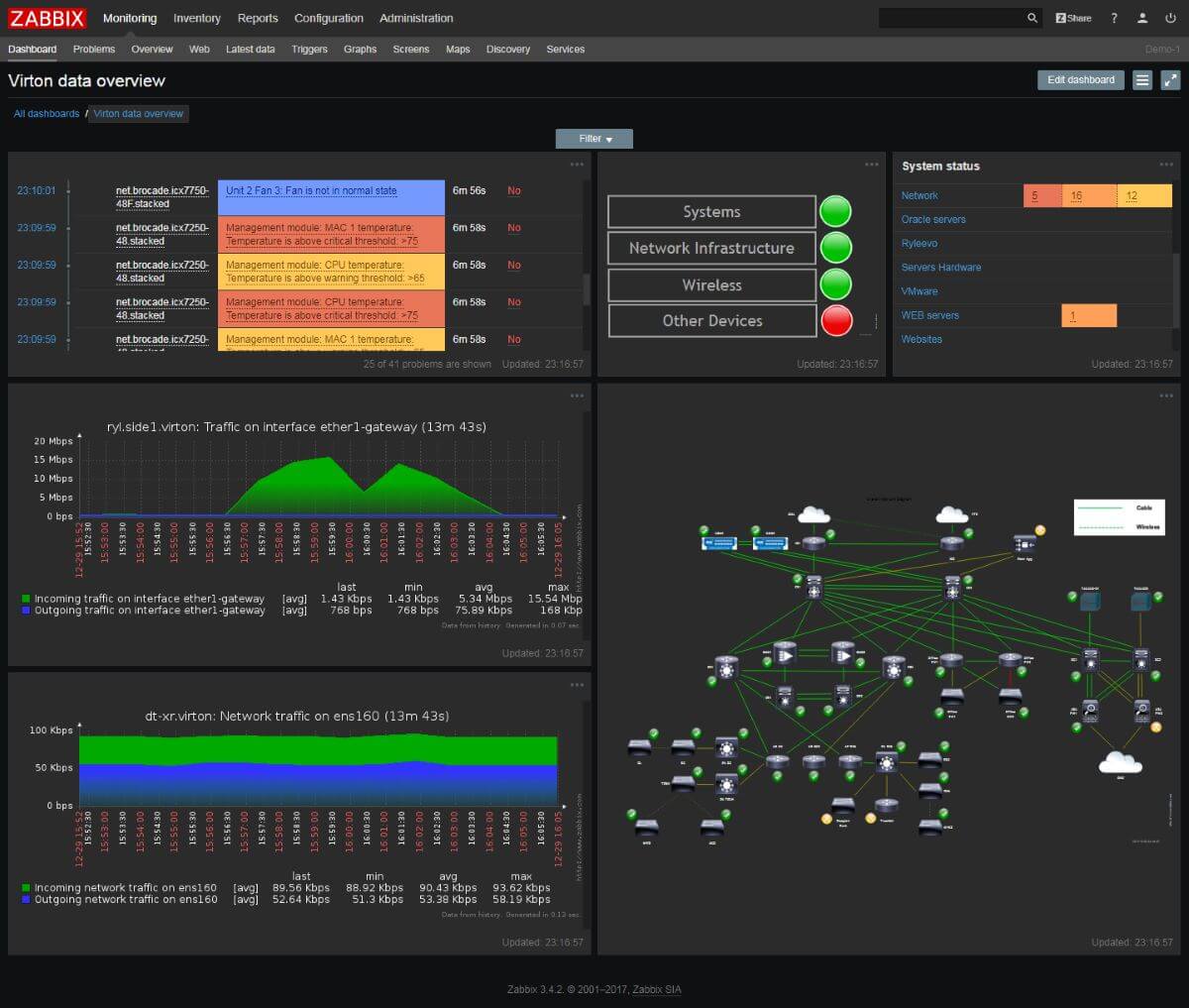



OpenNMS is a free and open-source network monitoring solution that provides auto-discovery, alerting, and reporting capabilities. It offers support for a wide range of devices and protocols, including SNMP, syslog, and ICMP. OpenNMS also includes cloud monitoring capabilities, allowing users to monitor cloud-based infrastructure, such as AWS and Azure, along with on-premises infrastructure.
It provides insights into cloud resource usage, performance, and availability, and supports monitoring of cloud services such as EC2 and RDS. OpenNMS also offers a Kubernetes plugin that allows users to monitor Kubernetes clusters and their components.
OpenNMS App Interface:
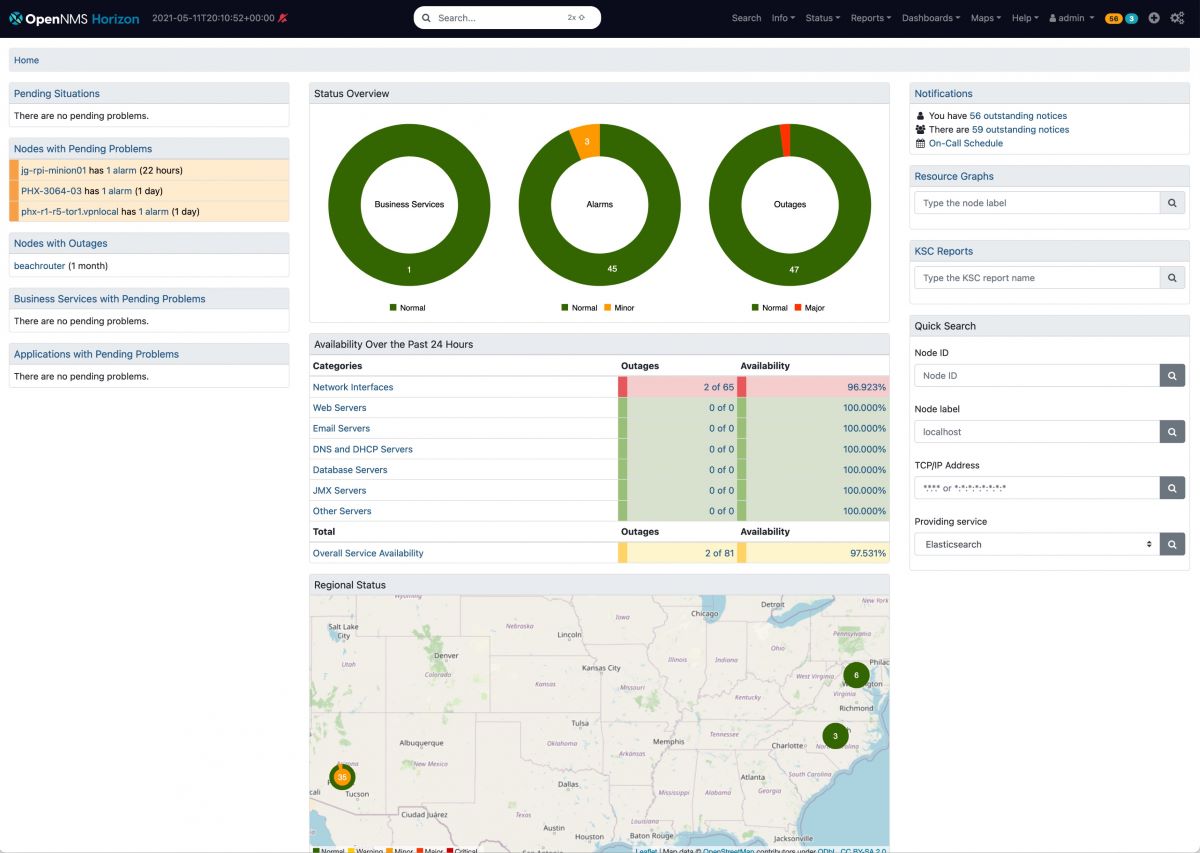

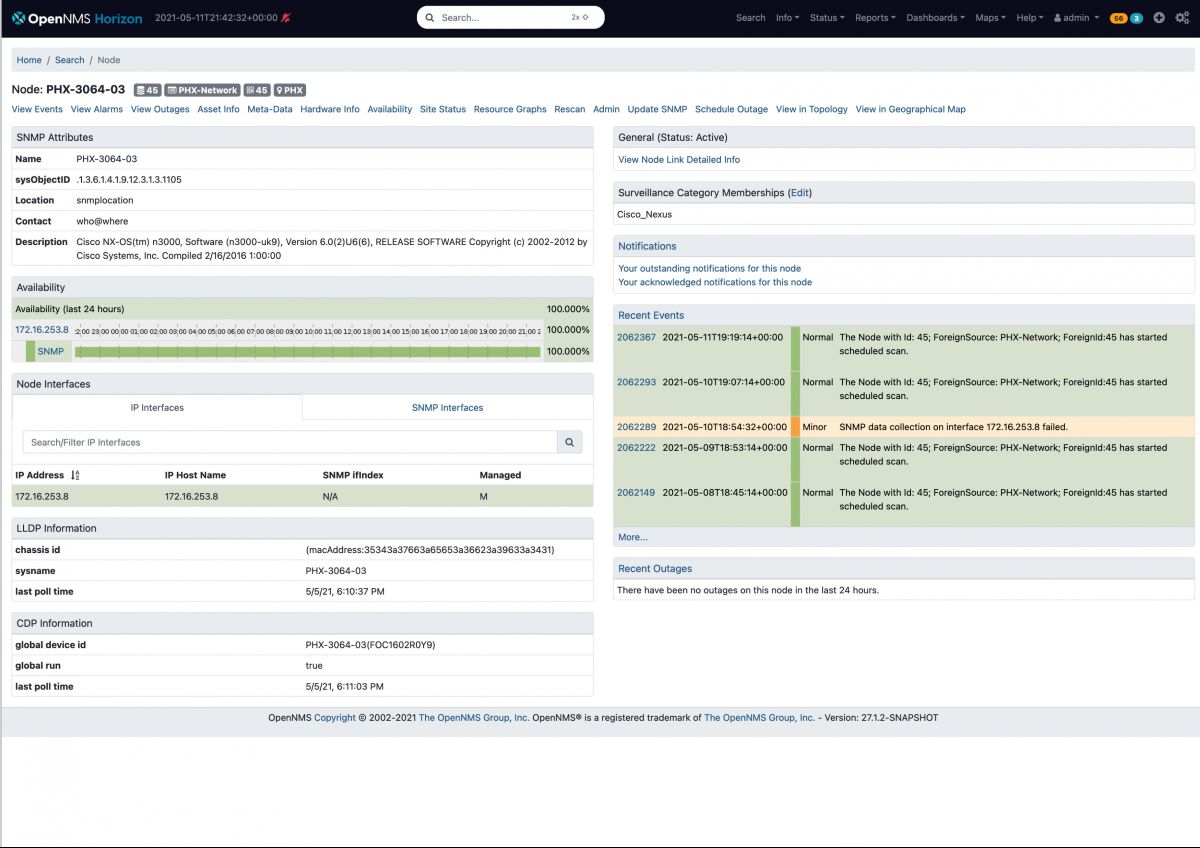

In this section, we will focus on six application performance monitoring tools that also offer network connection monitoring capabilities. These tools provide comprehensive visibility into both application performance and network connectivity, allowing organizations to optimize the end-to-end user experience. By monitoring network connections alongside application performance, these tools enable proactive management and troubleshooting.
Datadog is a monitoring and analytics platform that provides monitoring, alerting, tracing, and logging capabilities for applications and infrastructure. It offers full-stack network observability with support for over 450 integrations across more than 150 technologies, including AWS, Azure, GCP, Kubernetes, and Docker. Datadog's cloud monitoring services enable users to collect and analyze data from across their entire stack, providing deep insights into system performance and helping them troubleshoot issues quickly.
Datadog offers various pricing plans with different features and capabilities, so it's recommended to review their website and speak with a sales representative to determine the best plan and pricing for a specific use case.
Datadog App Interface:

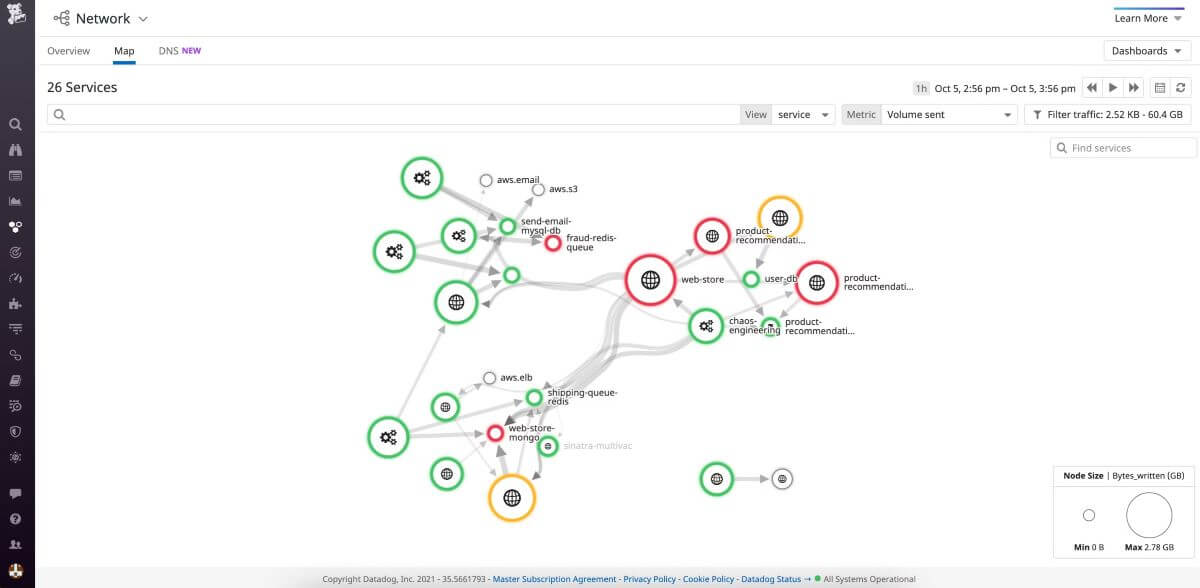
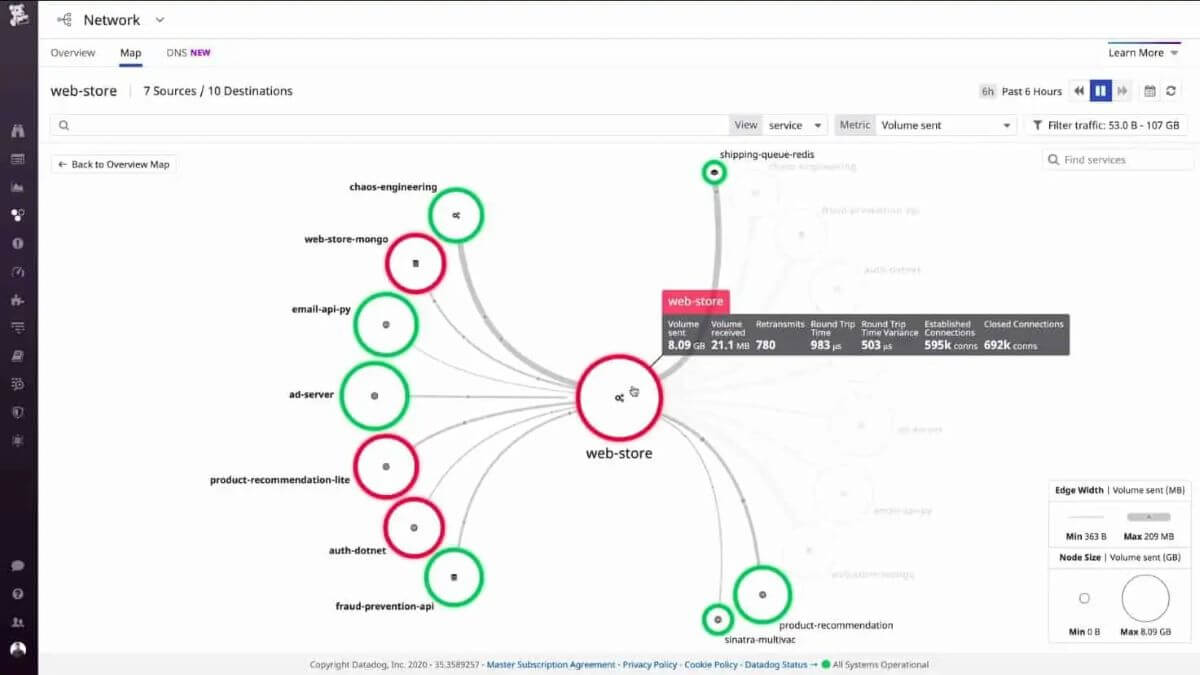
AppDynamics is an application performance monitoring (APM) solution that provides real-time insights into application performance, user experience, and business impact. It provides end-to-end visibility across application environments, including cloud, on-premises, and hybrid environments, enabling users to quickly identify and resolve issues before they impact end-users. AppDynamics' cloud monitoring services allow users to monitor their applications, microservices, and APIs in real-time and track performance metrics such as response times, error rates, and resource utilization.
AppDynamics provides the Advanced and Peak plans, which cater to the needs of larger enterprises, offering additional features such as multi-cloud support, machine learning, and analytics. It's essential to note that the pricing may vary based on the specific requirements of each organization, and AppDynamics also provides custom plans for businesses with complex environments.
AppDynamics App Interface:
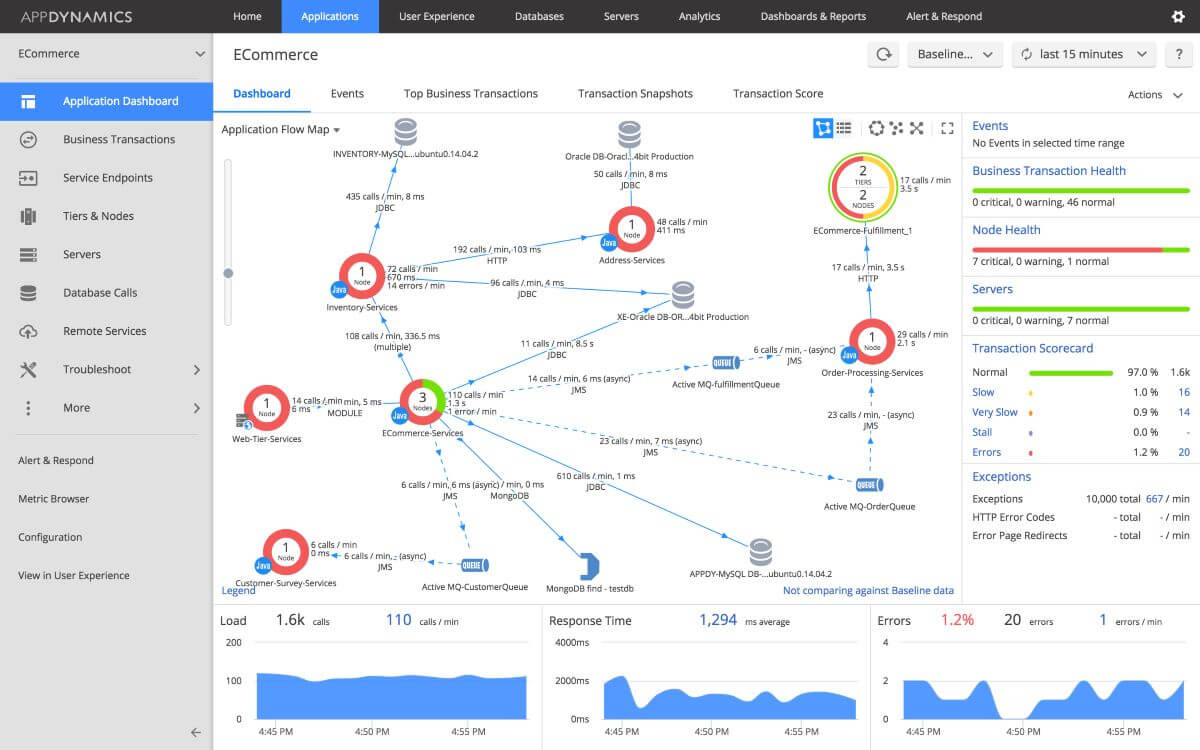
Dynatrace is an APM and digital experience management (DEM) solution that provides real-time insights into application performance, user experience, and business impact. It uses AI-powered automation to detect anomalies and performance issues, providing root cause analysis and recommendations for remediation. Dynatrace's cloud monitoring services allow users to monitor their applications and infrastructure across cloud, hybrid, and multi-cloud environments, providing visibility into cloud provider-specific metrics such as AWS, Azure, and Google Cloud.
Dynatrace offers full-stack monitoring, infrastructure monitoring, and digital experience monitoring with pricing that varies depending on factors such as the level of services and support needed, the size and complexity of the environment being monitored, and the length of the contract.
Dynatrace App Interface:
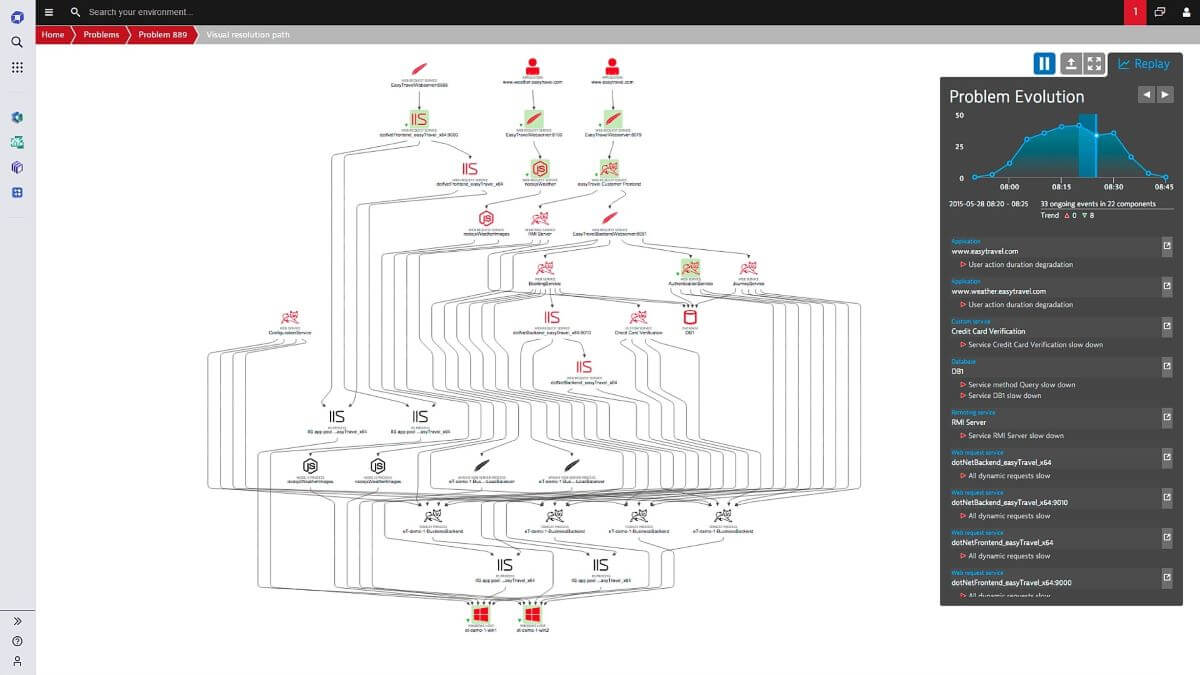
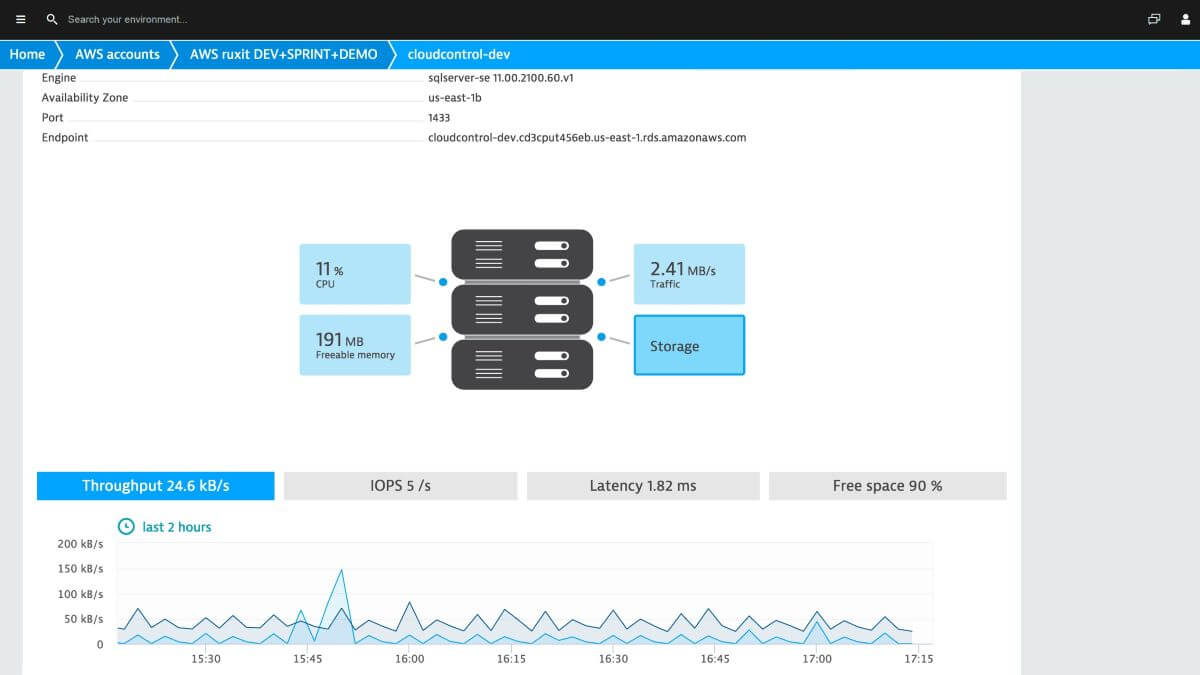
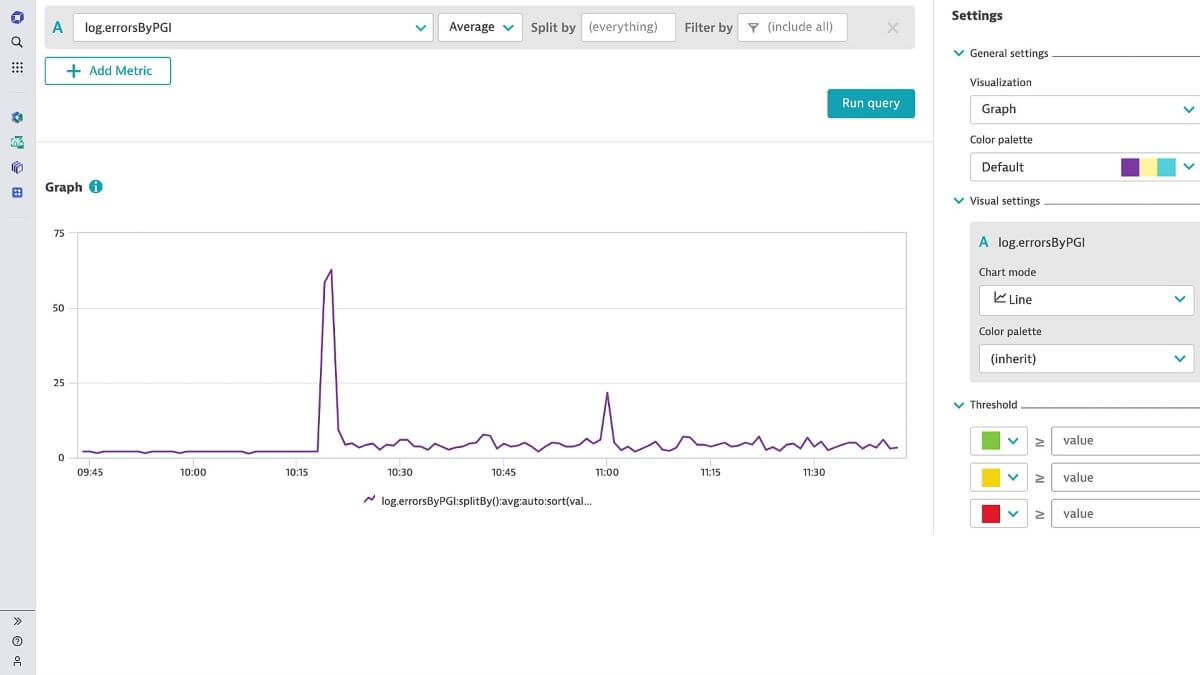
Splunk is a cloud-based platform that provides monitoring, logging, and analytics capabilities for applications and infrastructure. It offers machine learning-driven insights and predictive analytics for detecting and resolving issues, and provides support for over 300 integrations across multiple technology stacks. Splunk's cloud monitoring services allow users to monitor their entire stack, from infrastructure to application performance, and analyze data in real-time to identify issues and troubleshoot problems.
Splunk offers three pricing tiers for its Observability Cloud: Infrastructure, App & Infra, and End-to-End. Splunk also offers individual observability offerings, including Splunk Infrastructure Monitoring, Splunk APM, Splunk RUM, Splunk Synthetic Monitoring, Splunk On-Call, and Splunk IT Service Intelligence, each with their own starting prices.
Splunk App Interface:
New Relic is an APM solution that provides real-time insights into application performance, user experience, and business impact. It offers support for multiple languages, frameworks, and environments, including cloud, on-premises, and hybrid environments, and provides customizable dashboards and alerts for tracking performance metrics. New Relic's cloud monitoring services enable users to monitor their entire stack, including applications, infrastructure, and logs, and provides out-of-the-box integrations with popular cloud platforms such as AWS, Azure, and GCP.
New Relic App Interface:

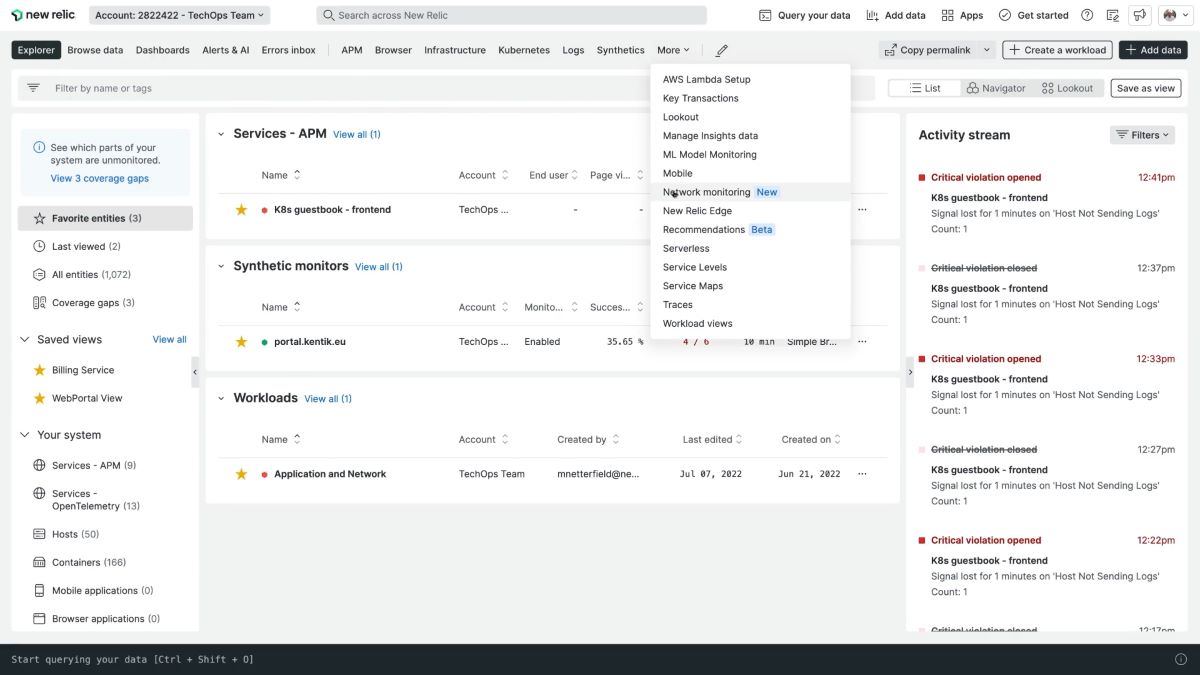
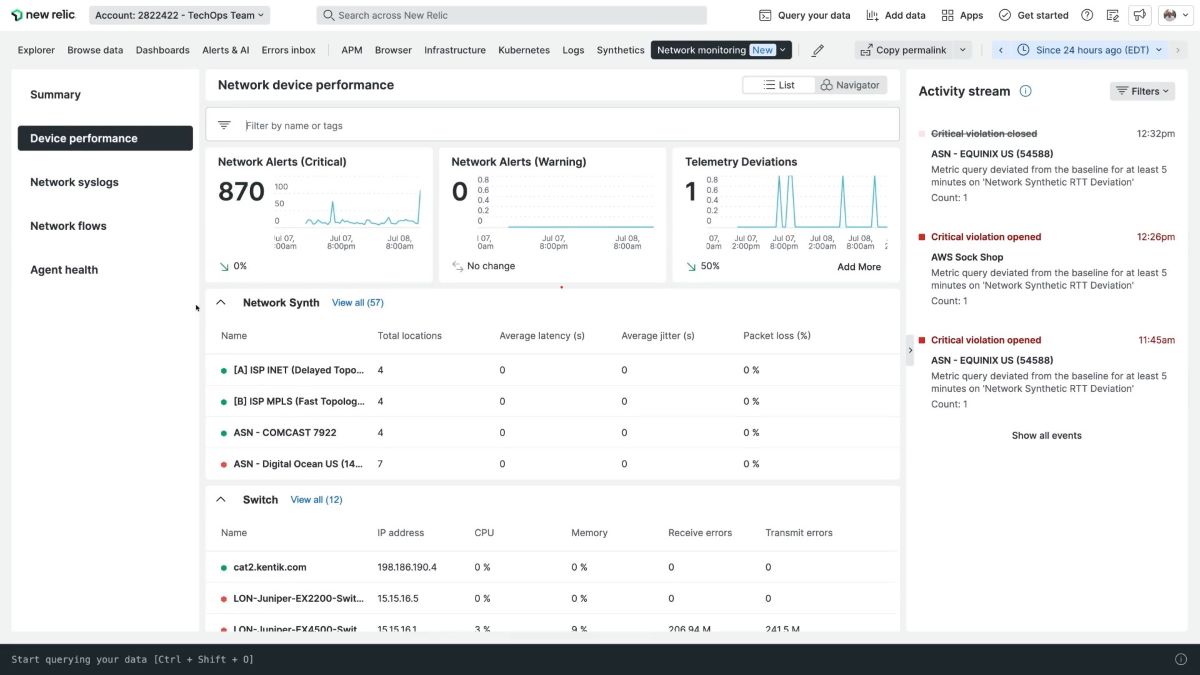
Elastic Observability is a cloud-based monitoring and observability solution that provides real-time insights into application performance, infrastructure, and logs. It offers support for multiple technologies and integrations, including AWS, Azure, and GCP, and provides customizable dashboards and alerts for tracking performance metrics. Elastic Observability's cloud monitoring services enable users to monitor their entire stack, from infrastructure to application performance, and analyze data in real-time to identify issues and troubleshoot problems.
Elastic Observability offers four pricing tiers based on the level of features and support provided. Each tier includes additional features like security, observability applications for APM, logging, and metrics, and advanced security features, machine learning capabilities for anomaly detection, cross-cluster replication, searchable snapshots, support for searchable cold and frozen tiers, and Elastic Maps Server.
Elastic Observability App Interface:

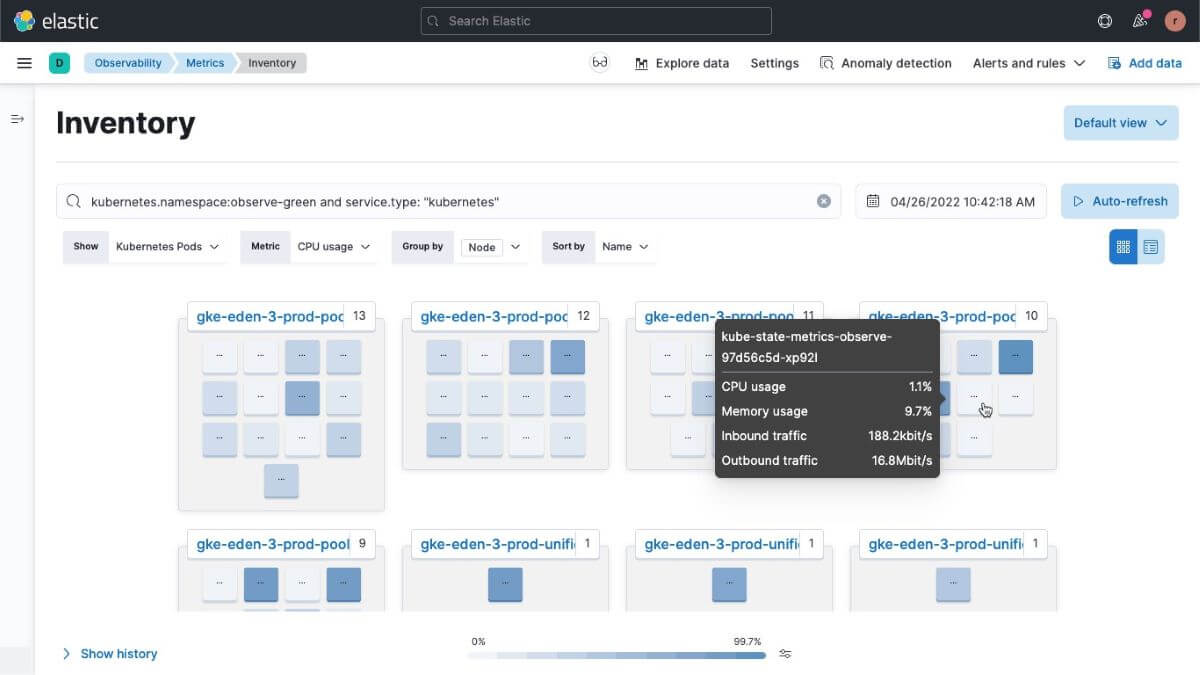

In this section, we will explore six packet capture-based network connection monitoring tools that prioritize high security. These passive network monitoring tools capture and analyze network traffic at the packet level, providing detailed visibility into network behavior. With a focus on security, they enable IT teams to detect potential threats, optimize network performance, and ensure the integrity of network connections.
Ixia/Keysight Network Monitoring provides [network visibility] and security solutions to enterprises and service providers. Their cloud network monitoring solution offers visibility into public, private, and hybrid cloud environments. It provides packet-level visibility, performance monitoring, and security analysis of network traffic in the cloud. The solution can be deployed as a virtual machine or on-premises appliance.
Ixia/Keysight App Interface:
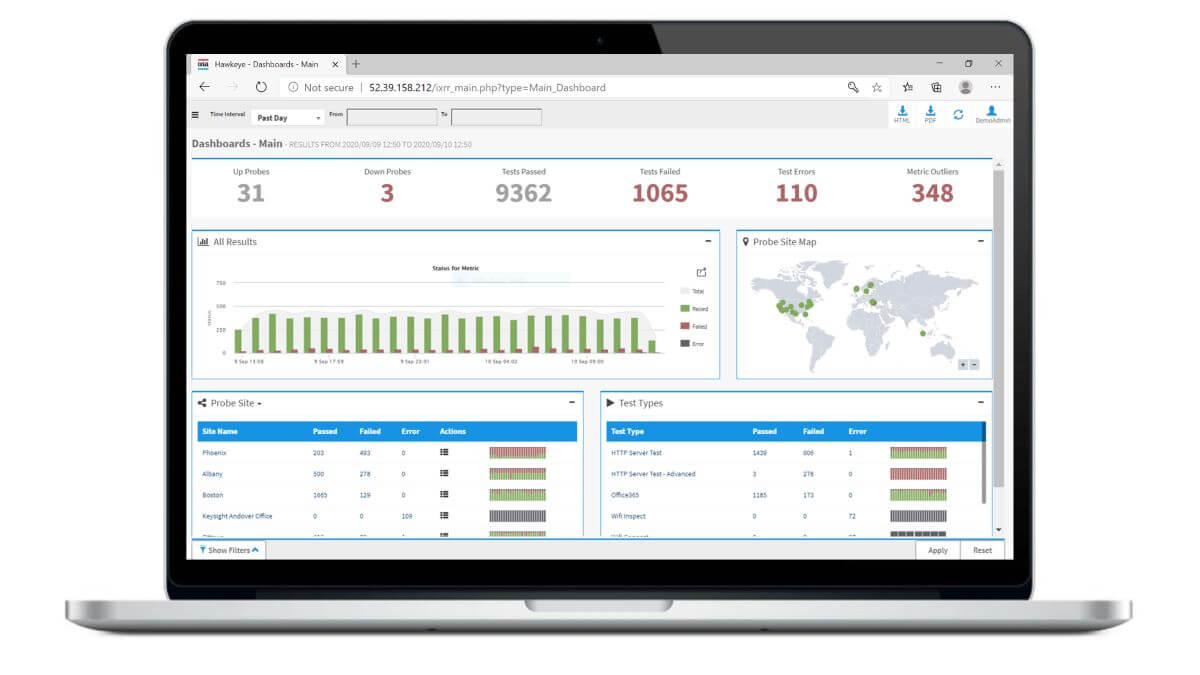
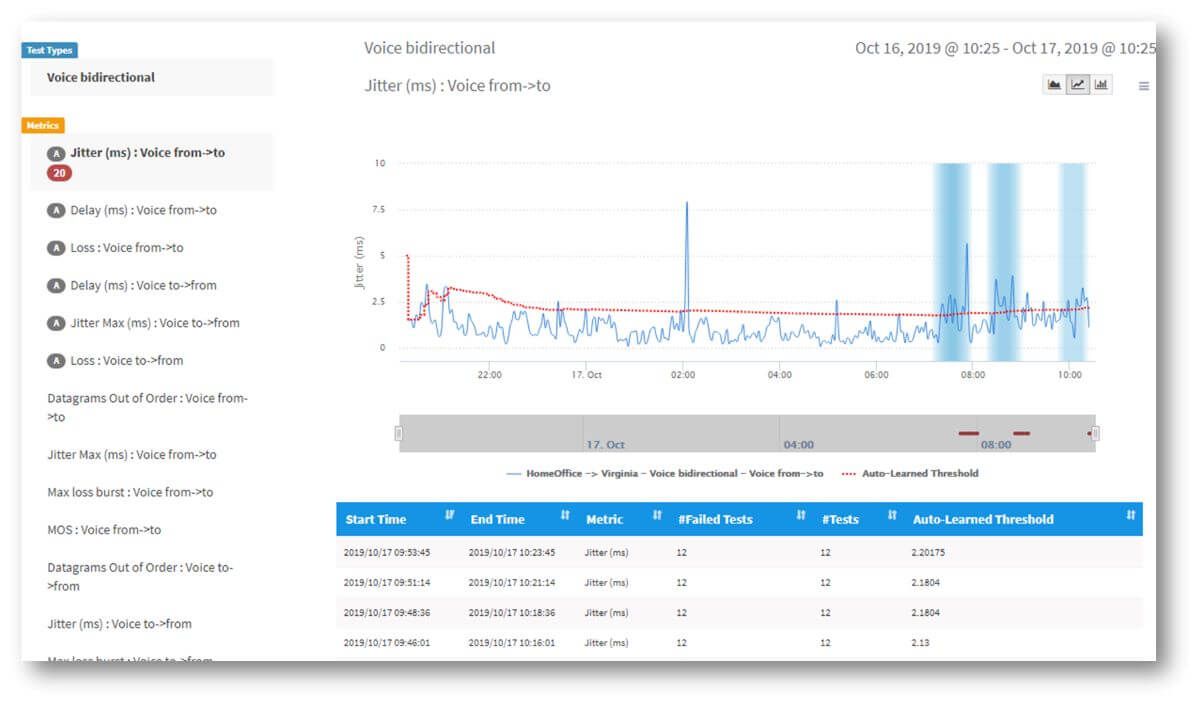
Viavi Observer Solutions offers a comprehensive network performance management solution for enterprises, service providers, and government agencies. Their cloud network monitoring solution provides end-to-end visibility across hybrid cloud environments. It offers real-time analytics and diagnostics of cloud network performance, identifying and resolving issues before they impact users. The solution is available as a SaaS or on-premises deployment.
Viavi Solutions App Interface:


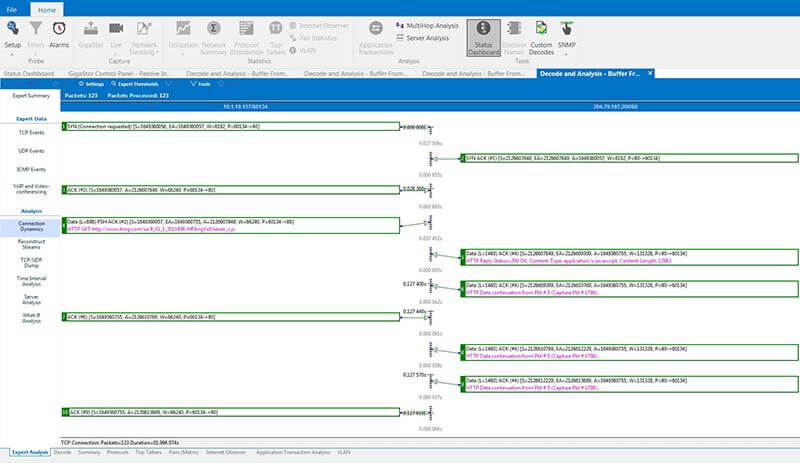
Gigamon provides a cloud visibility and analytics platform for monitoring and securing hybrid cloud environments. Their cloud network monitoring solution offers real-time visibility into network traffic across public, private, and hybrid cloud environments. It enables IT teams to monitor and optimize network performance, detect and respond to security threats, and ensure compliance. The solution can be deployed as a physical or virtual appliance, or as a SaaS offering.
Gigamon offers a range of products for network monitoring and its pricing varies based on the features and support provided.
Gigamon App Interface:
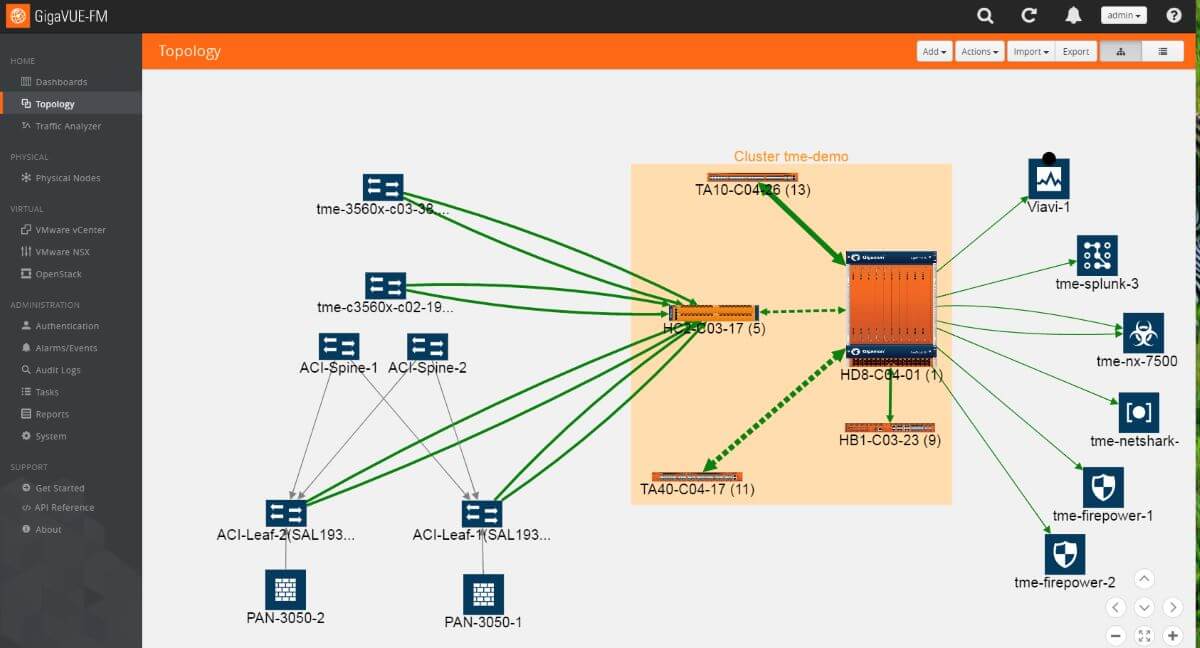
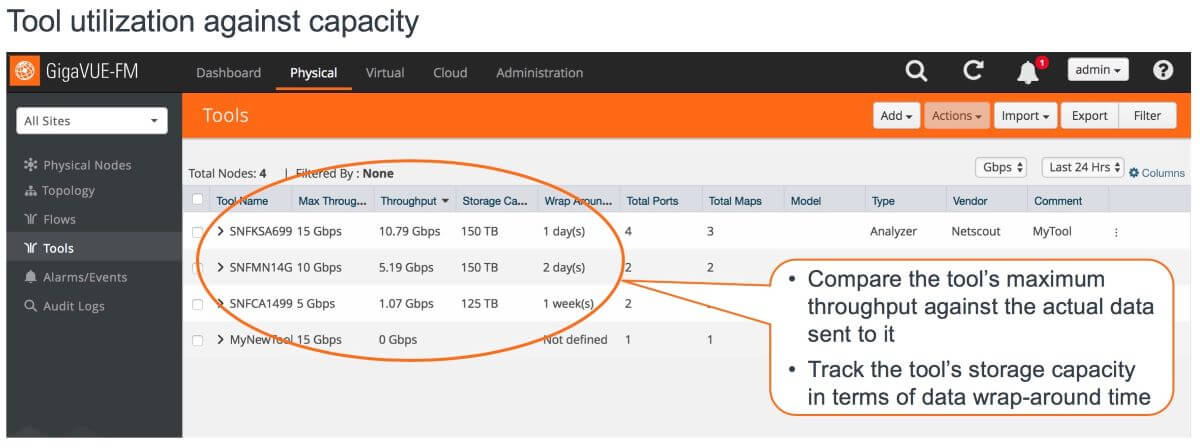
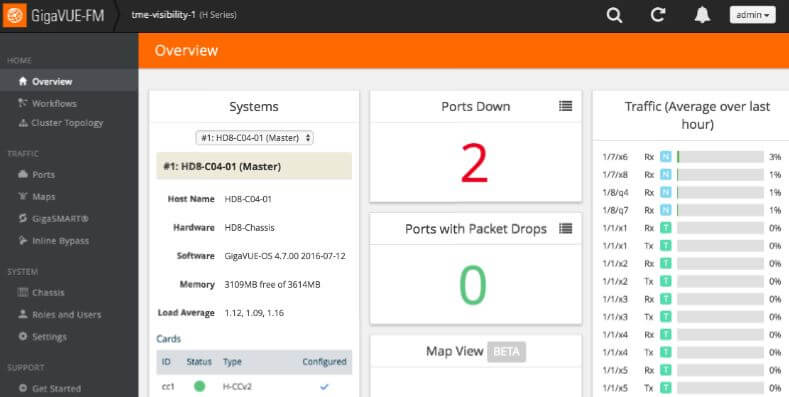
Netscout nGeniusOne is a network and application performance management solution for enterprises and service providers. Their cloud network monitoring solution offers end-to-end visibility into multi-cloud environments, including AWS, Azure, and Google Cloud. It provides real-time analytics and diagnostics of network performance, ensuring that applications are running smoothly and user experience is optimized. The solution is available as a SaaS or on-premises deployment.
Netscout nGeniusOne App Interface:

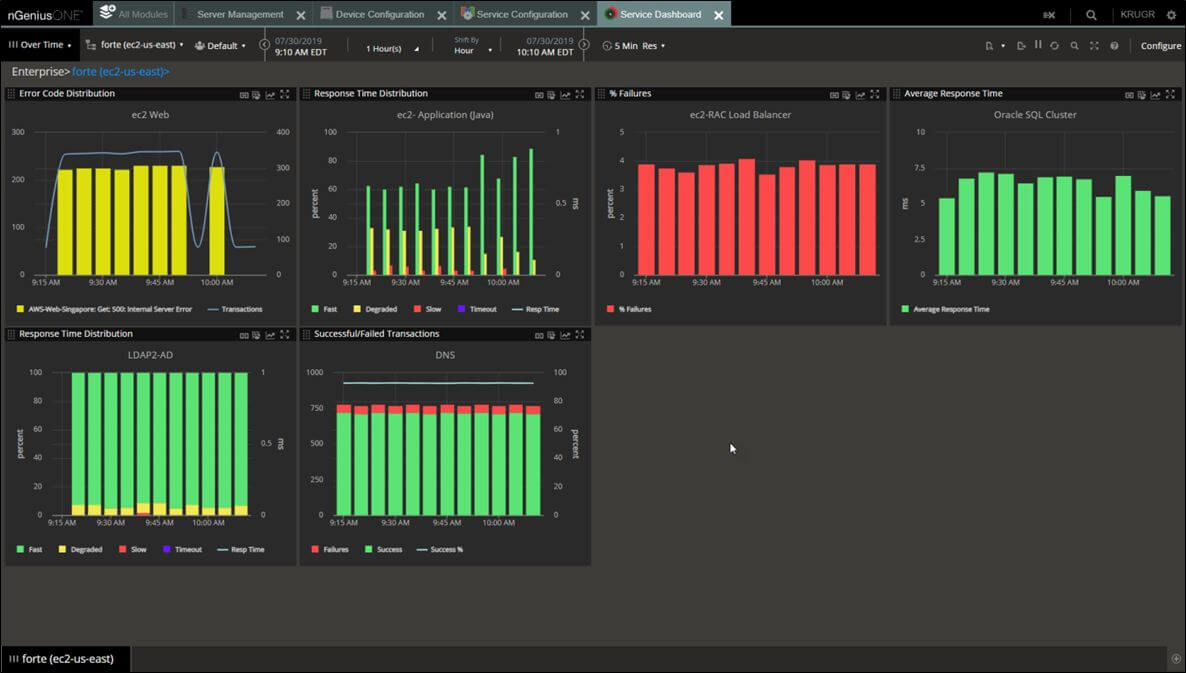
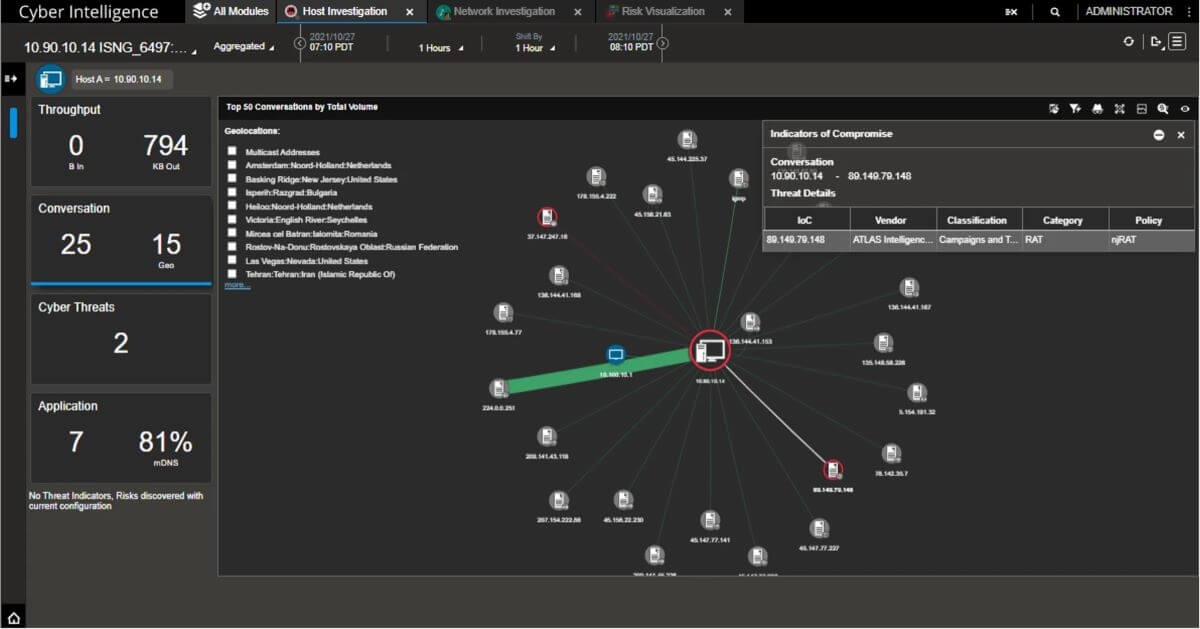
Extrahop Revealx is a cloud-native network detection and response (NDR) solution for securing hybrid cloud environments. Their cloud network monitoring solution provides full visibility into network traffic, detecting and responding to security threats in real-time. It offers automated threat detection and response, ensuring that IT teams can quickly remediate security incidents before they cause damage. The solution is available as a SaaS offering.
Extrahop Revealx App Interface:
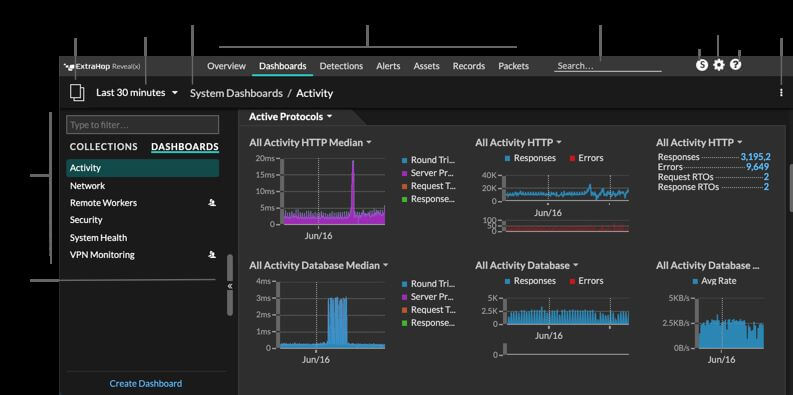
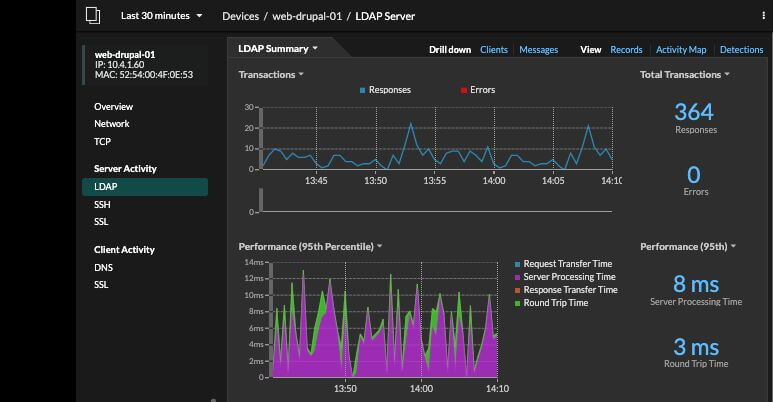

Skylight is a cloud-native network and application performance monitoring solution for enterprises and service providers. Their cloud network monitoring solution offers real-time visibility into network traffic across multi-cloud environments. It provides end-to-end network performance monitoring, ensuring that applications are running smoothly and user experience is optimized. The solution can be deployed as a SaaS or on-premises deployment.
Accedian's Skylight Platform is one of the network monitoring solutions for which pricing information is not publicly available.
Skylight App Interface:
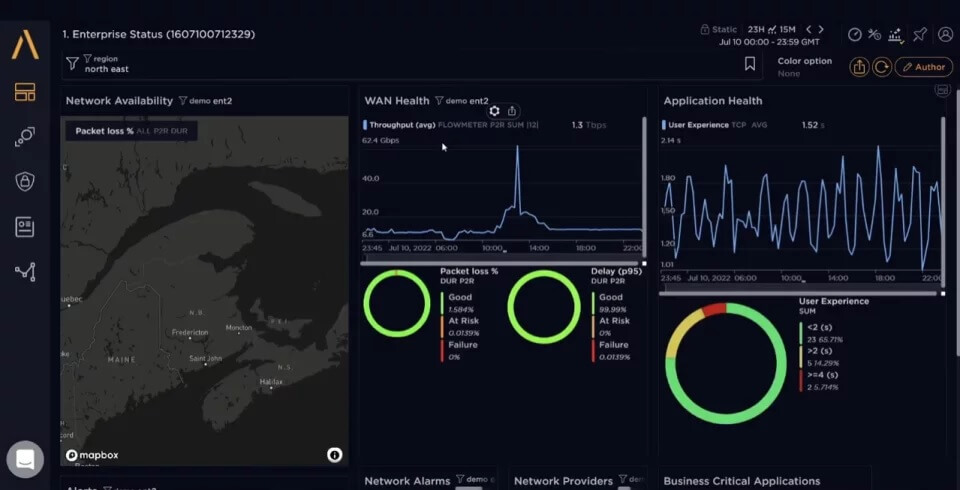
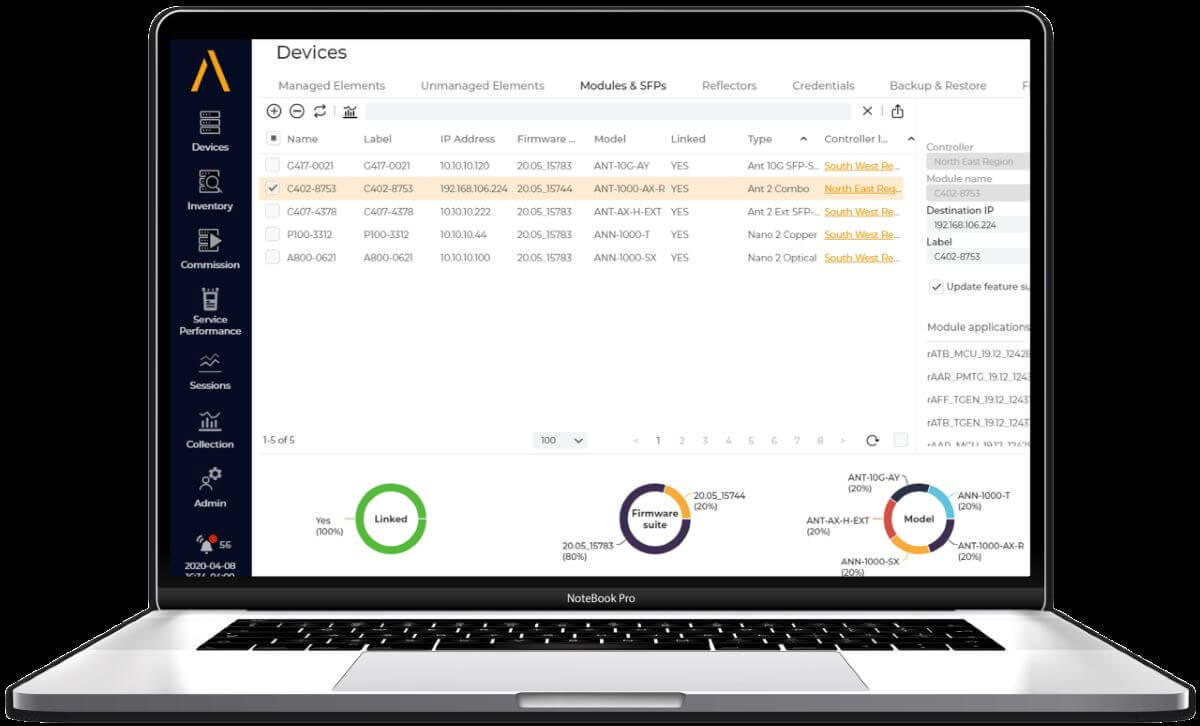
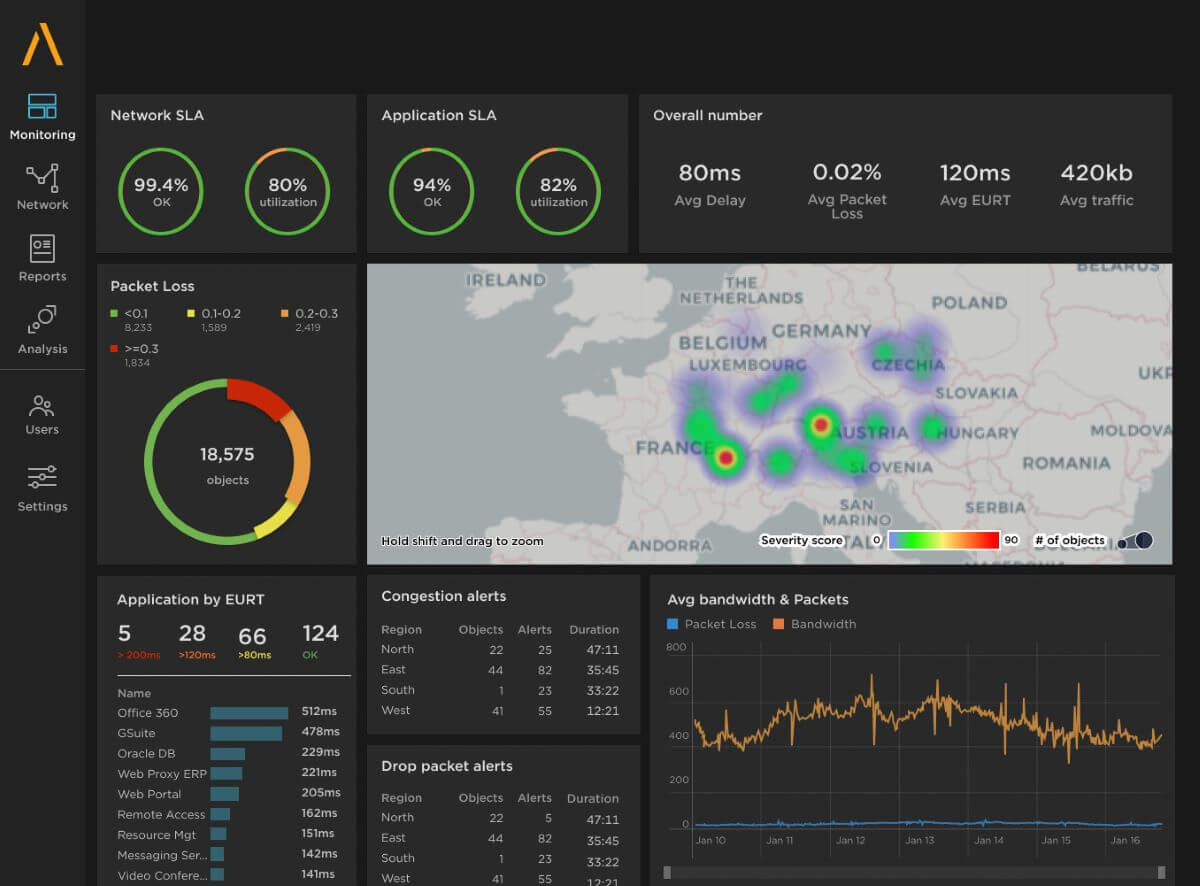


We hope that this article has provided valuable insights and assistance in your research for the perfect network connection monitoring tools. Our goal has been to help you navigate the vast landscape of options and find a solution that best fits your specific needs and requirements.
At Obkio, we prioritize a user-first approach, and our network connection software is designed with simplicity and ease of use in mind. If you are looking for a hassle-free way to monitor your network connections, we invite you to try Obkio. With our user-friendly platform, you can get started in less than 10 minutes without the need for extensive investment or technical expertise.

Rest assured, we are not salesy, and we respect your decision even if you choose to explore other options. We won't hassle you with unwanted follow-ups. Our focus is to provide you with a reliable network connection monitoring solution that empowers you to ensure seamless connectivity and optimize your network performance.
- 14-day free trial of all premium features
- Deploy in just 10 minutes
- Monitor performance in all key network locations
- Measure real-time network metrics
- Identify and troubleshoot live network problems

Thank you for considering Obkio, and we look forward to assisting you on your network monitoring journey.
This page is compiled from the information available on the software’s official website. We have made every attempt to ensure the accuracy and reliability of the information provided in this article. However, the information is provided “as is” without warranty of any kind. Obkio is not liable for any inaccuracies in the article due to changes made on their websites or any development made to their products after the date of publication of this article. Please refer to their websites for more information.


























 Obkio Blog
Obkio Blog




